Documents: Go to download!
User Manual
- User Manual - (English)
- Product spec sheet - (English)
- EU Datasheet - (English)
- EU Energy Label - (English)
- Installation instructions - (English)
- Getting to know your appliance
- Accessories
- Before using for the first time
- Operating the appliance
- Time-setting options
- Childproof lock
- Basic settings
- Cleaning agent
- Cleaning function
- Rails
- Appliance door
- Trouble shooting
Table of contents
Owner Manual DOUBLE OVEN
Getting to know your appliance
In this section, we will explain the indicators and controls. You will also find out about the various functions of your appliance.
Note: Depending on the appliance model, individual details and colours may differ.
Control panel
You can set your appliance's various functions on the control panel. Below, you will see an overview of the control panel and the layout of the controls.

- Buttons and display
The buttons are touch keys with sensors underneath. Simply touch a symbol to select the function.
The display shows symbols for active functions and the time-setting options. - Main oven

Controls for the main oven - Function selector

Use the function selector to set the type of heating or other functions for the main oven.
You can turn the function selector clockwise or anti-clockwise from the "Off" position. - Temperature selector

See other models: K8524X0/01 B1531N2/05 T20S31N0/06 G7161X0/99 T1843N0/01
Use the temperature selector to set the temperature for the type of heating or select the setting for other functions for the main oven.
You can only turn the temperature selector clockwise from the "Off" position, until it offers resistance. Do not turn the selector beyond this point. - Heating-up indicator

The heating-up indicator for the main oven remains lit while the appliance is heating. - Top oven

Controls for the top oven - Function selector

Use the function selector to set the type of heating or other functions for the top oven.
You can turn the function selector clockwise or anti-clockwise from the "Off" position. - Temperature selector

Use the temperature selector to set the temperature for the type of heating or select the setting for other functions for the top oven.
You can only turn the temperature selector clockwise from the "Off" position, until it offers resistance. Do not turn the selector beyond this point. - Heating-up indicator

The heating-up indicator for the top oven remains lit while the appliance is heating.
Note: On some appliances, the control knobs can be pushed in. To push the control knob in and engage it or to release it again, turn it to the "Off" position.
Buttons and display
You can use the buttons to set various additional functions on your appliance. You will be able to see the values for these on the display.

Display
The value that can be set immediately or that is elapsing is shown in large digits in the display.
To use the individual time-setting options, tap the  button several times. If there is a red bar above or below a symbol, this means that the value being shown in large digits on the display refers to the function that this symbol represents.
button several times. If there is a red bar above or below a symbol, this means that the value being shown in large digits on the display refers to the function that this symbol represents.
Types of heating and functions
Use the function selector to set the types of heating and other functions.
To make sure you always use the right type of heating to cook your food, we have explained the differences and applications below.
Note: Not all heating functions and other functions are available for both ovens. To find out which ones are available, see the symbols on the controls.

Other functions
Your new oven has yet more functions; see below for a brief description of these.


Temperature
Use the temperature selector to set the temperature in the cooking compartment. You can also use it to select the settings for other functions.
For temperature settings above 250 °C, the appliance reduces the temperature to approx. 240 °C after approx. 10 minutes. If your appliance has the top/ bottom heating or bottom heating types, this reduction does not take place.

Cooking compartment
Various functions in the cooking compartment make your appliance easier to use. For example, the cooking compartment is well lit and a cooling fan prevents the appliance from overheating.
Opening the appliance door
If you open the appliance door when the appliance is in operation, the appliance will continue to operate as before.
Interior lighting
With most heating functions and other functions, the interior lighting in the cooking compartment will remain lit while the oven is in operation. When the function selector is turned to bring operation to an end, the lighting will go out.
By turning the function selector to the interior lighting setting, you can switch on the lighting without heating the oven. This makes it easier to clean your appliance, for example.
Cooling fan
The cooling fan switches on and off as required. The hot air escapes above the door.
Caution! Do not cover the ventilation slots. Otherwise, the appliance may overheat.
So that the cooking compartment cools down more quickly after operation, the cooling fan continues to run for a certain period afterwards.
Accessories
Your appliance is accompanied by a range of accessories. Here, you can find an overview of the accessories included and information on how to use them correctly.
Control accessories
The accessories supplied may differ depending on the appliance model.

Only use original accessories. They are specially adapted for your appliance.
You can buy accessories from the after-sales service, from specialist retailers or online.
Note: The accessories may deform when they become hot. This does not affect their function. Once they have cooled down again, they regain their original shape.
Inserting accessories
The shelf positions are counted from the bottom up.
The main cooking compartment
The main cooking compartment has four shelf positions.
Depending on the appliance model, your cooking compartment will have one or more pull-out rails. There are
- fixed pull-out rails that cannot be removed
- Clip-on pull-out rails, which can be removed and fitted to a different level as required

Always insert accessories between the two guide rods for the shelf position.
Accessories can be pulled out approximately halfway without tipping. You can use the pull-out rails to pull the accessories out further.
Make sure that the accessory is placed behind the lug a on the pull-out rail.
Example in the picture: Universal pan
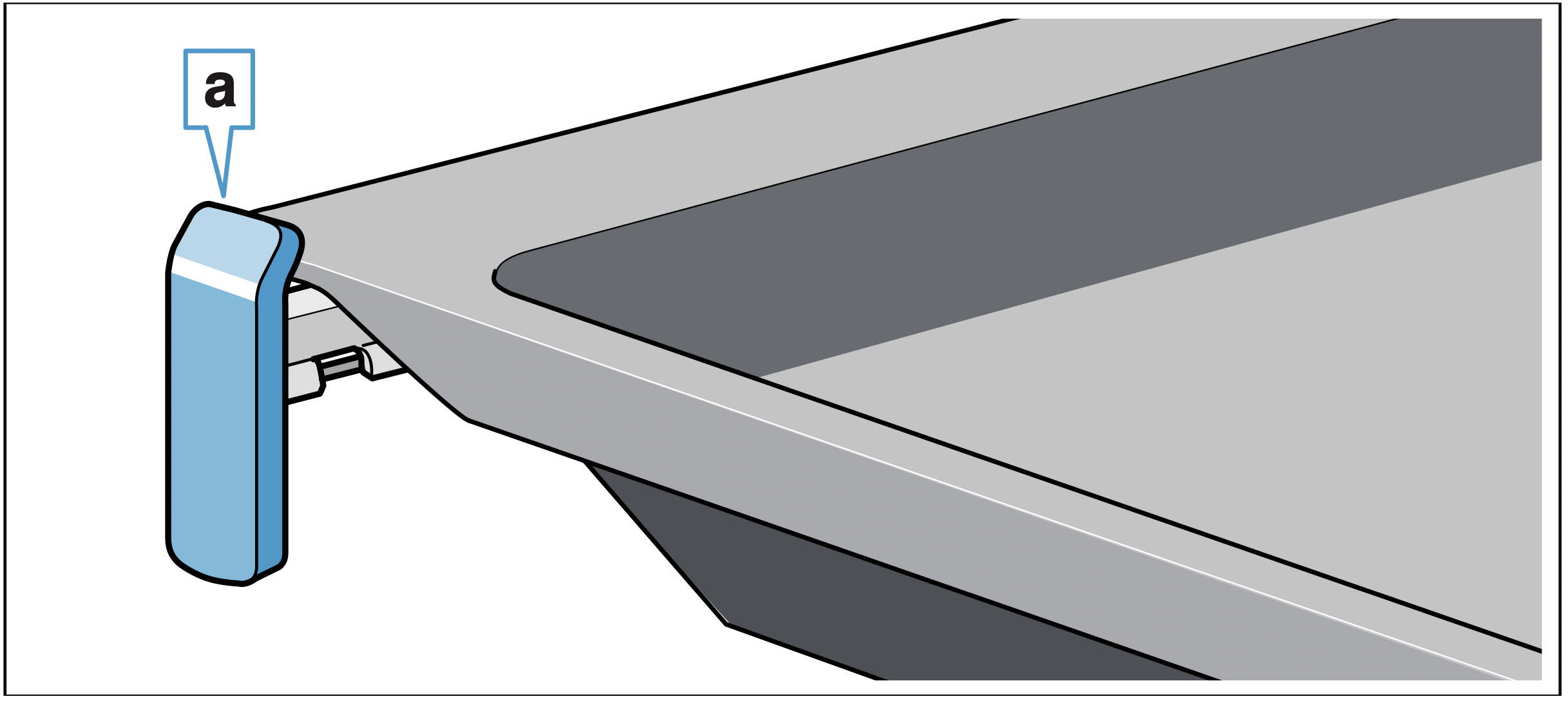
The pull-out rails lock in place when they are fully pulled out. This makes it easy to place the accessories in position. To unlock the pull-out rails, use a little force to push them back into the cooking compartment.
Notes
- Make sure that you always insert the accessories into the cooking compartment the right way round.
- Always insert the accessories fully into the cooking compartment so that they do not touch the appliance door.
- Take any accessories that you will not be using out of the cooking compartment.
- The shelf supports can be taken out of the cooking compartment for cleaning.
The top cooking compartment
The top cooking compartment has three shelf positions.
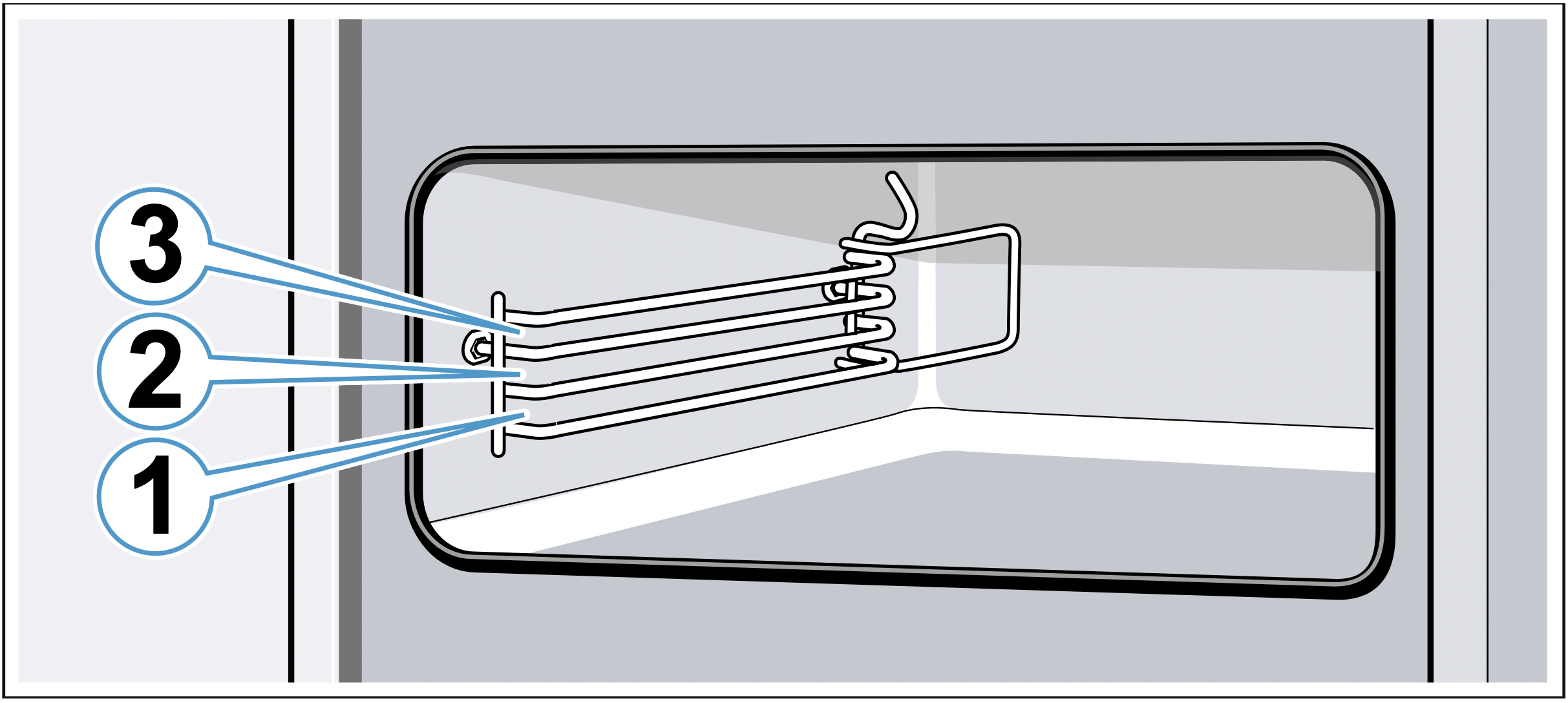
Always insert accessories between the two guide rods for the shelf position.
Accessories can be pulled out approximately halfway without tipping.
Notes
- Make sure that you always insert the accessories into the cooking compartment the right way round.
- Always insert the accessories fully into the cooking compartment so that they do not touch the appliance door.
- Take any accessories that you will not be using out of the cooking compartment.
Locking function
The accessories can be pulled out approximately halfway until they lock in place. The locking function prevents the accessories from tilting when they are pulled out. The accessories must be inserted into the cooking compartment correctly for the tilt protection to work properly.
When inserting the wire rack, ensure that lug a is at the rear and is facing downwards. The open side must be facing the appliance door and the outer rail must be facing downwards  .
.
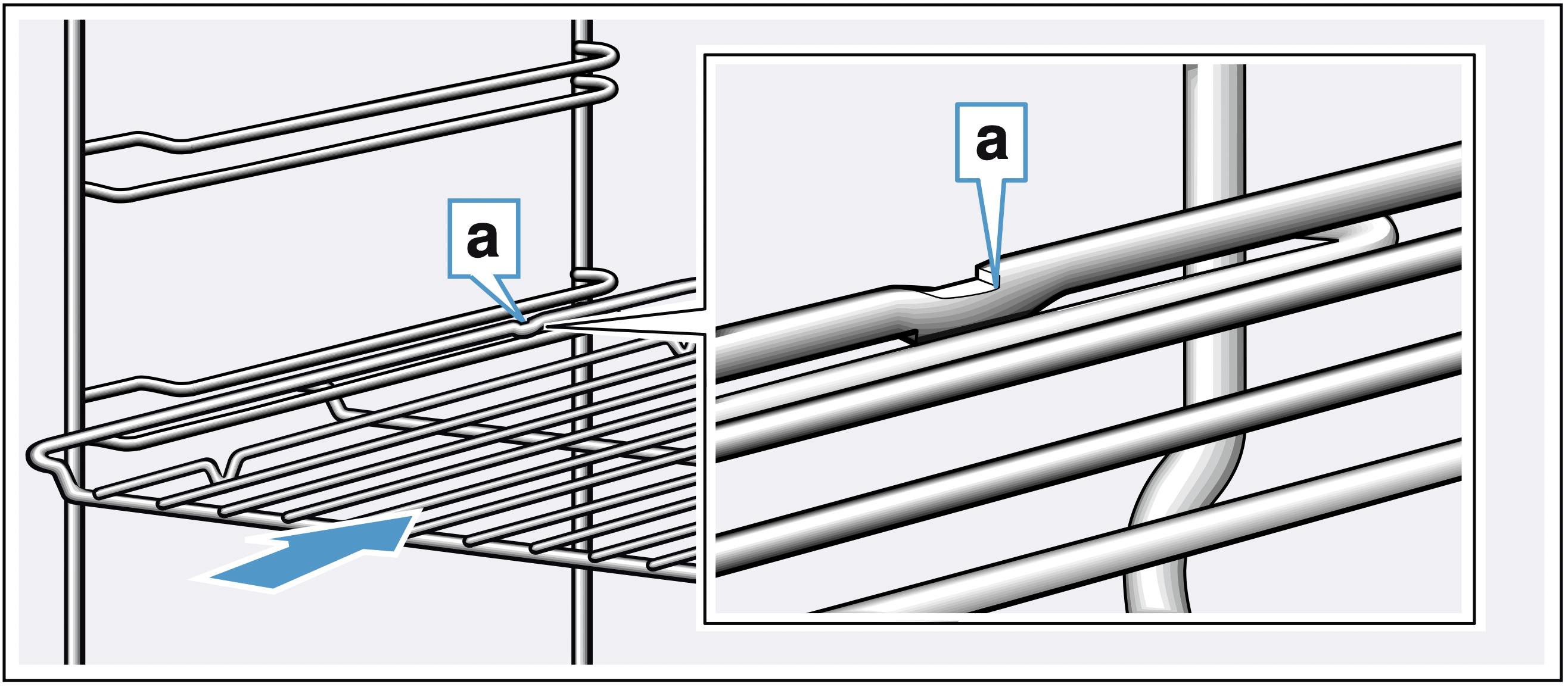
When inserting baking trays, make sure that the recess a is at the rear and is facing downwards. The sloping edge of the accessory b must be facing towards the appliance door.
Example in the picture: Universal pan

Combining accessories
You can insert the wire rack and the universal pan at the same time to catch drops of liquid.
When inserting the wire rack, ensure that both spacers a are at the rear edge. When inserting the universal pan, the wire rack is on top of the upper guide rod of the shelf position.
Example in the picture: Universal pan
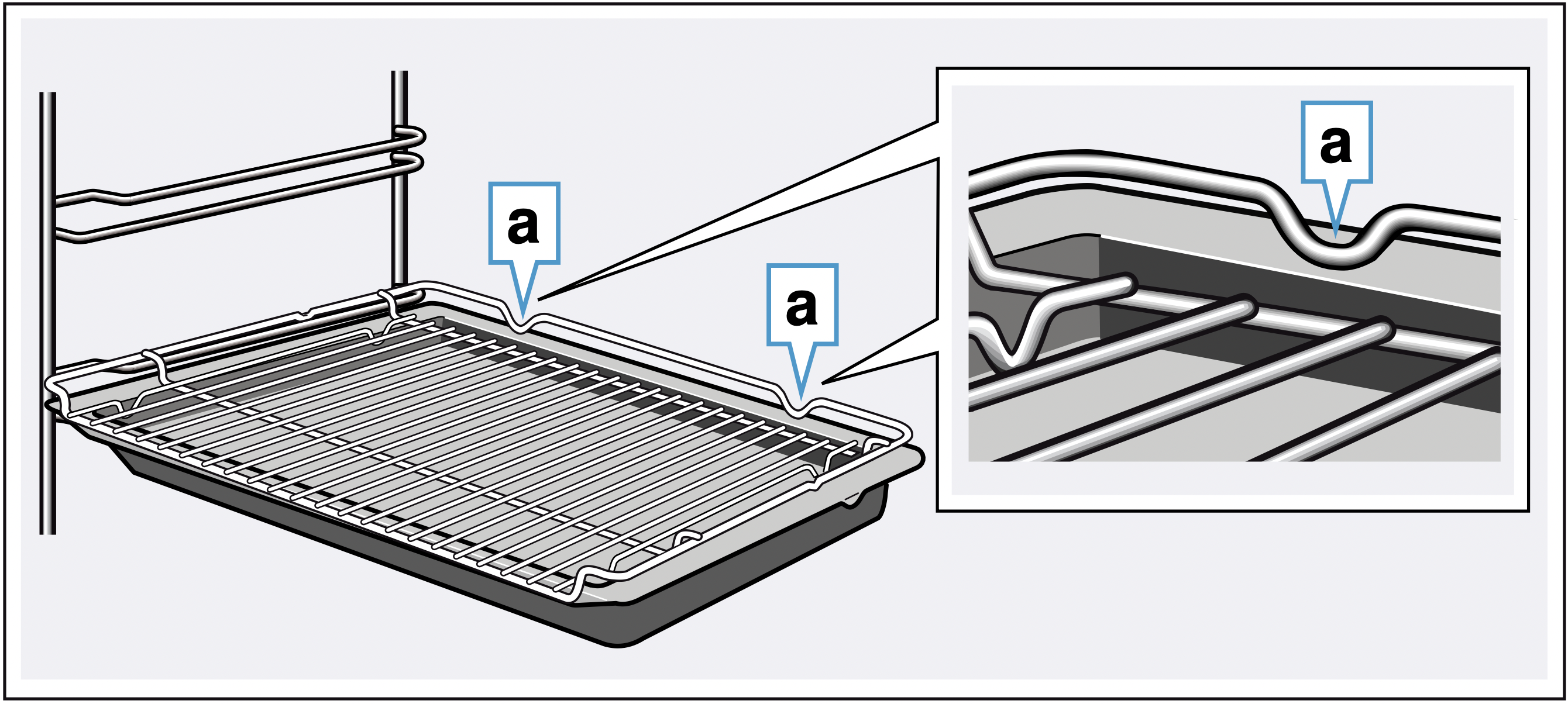
Optional accessories
You can purchase optional accessories from the aftersales service and specialist retailers, or on the Internet. You will find a comprehensive range of products for your appliance in our brochures and on the Internet.
Both availability and whether it is possible to order online differ between countries. Please see your sales documents for more details.
Note: Not all optional accessories are suitable for every appliance. When purchasing, please always quote the exact designation (E no.) of your appliance. "Customer service" on page 26
Accessories
- Baking and roasting shelf
- Baking tray
- Universal pan
- Baking tray, non-stick
- Universal pan, non-stick
- Extra-deep pan
- Steaming set for ovens
- Profi pan
- Lid for the Profi pan
- Pizza tray
- Grill tray
- Ceramic brick
- Glass roasting dish, 5.1 litres
- Glass pan
- ComfortFlex rail (1 level)*
- 3 x fully extendable pull-out rack*
*Accessory does not fit in every appliance, quote the E no. when ordering
Before using for the first time
Before you can use your new appliance, you must make some settings. You must also clean the cooking compartment and accessories.
Initial use
As soon as the appliance is connected to the power supply,  flashes in the display.
flashes in the display.
Setting the time
Use the ( or ) buttons to set the current time.
After a few seconds, the time that has been set is adopted.
Changing the time
- Press the
 button repeatedly until the
button repeatedly until the  symbol lights up.
symbol lights up. - Use the ( or ) button to change the time.
After a few seconds, the time that has been set is adopted.
Cleaning the cooking compartment
To eliminate the new-appliance smell, heat up the cooking compartment without anything in it and with the oven door closed.
- Remove the accessories from the cooking compartment.
- Remove any leftover packaging, such as polystyrene pellets, from the cooking compartment.
- Before heating the appliance, wipe the smooth surfaces in the cooking compartment with a soft, damp cloth.
- Set the specified type of heating and temperature.

- Keep the kitchen ventilated while the appliance is heating.
- Switch off the appliance after the specified cooking time.
- Wait until the cooking compartment has cooled down.
- Clean the smooth surfaces with soapy water and a dish cloth.
Cleaning the accessories
Clean the accessories thoroughly using soapy water and a dish cloth or soft brush.
Operating the appliance
You have already learnt about the controls and how they work. Now we will explain how to apply settings on your appliance.
Switching the appliance on and off
Use the function selector to switch the appliance on or off. Turning the function selector to any position other than the "Off" position switches on the appliance. To switch off the appliance, always turn the function selector to the "Off" position.
Setting the heating function and temperature
It is very easy to apply the settings you require to your appliance using the function and temperature selector. To find out which heating function is best for which type of food, please refer to the beginning of the instruction manual. "Getting to know your appliance" on page 8
Example in the picture: CircoTherm hot air  at 160 °C.
at 160 °C.
- Use the function selector to set the heating function.
- Use the temperature selector to set the temperature or grill setting.
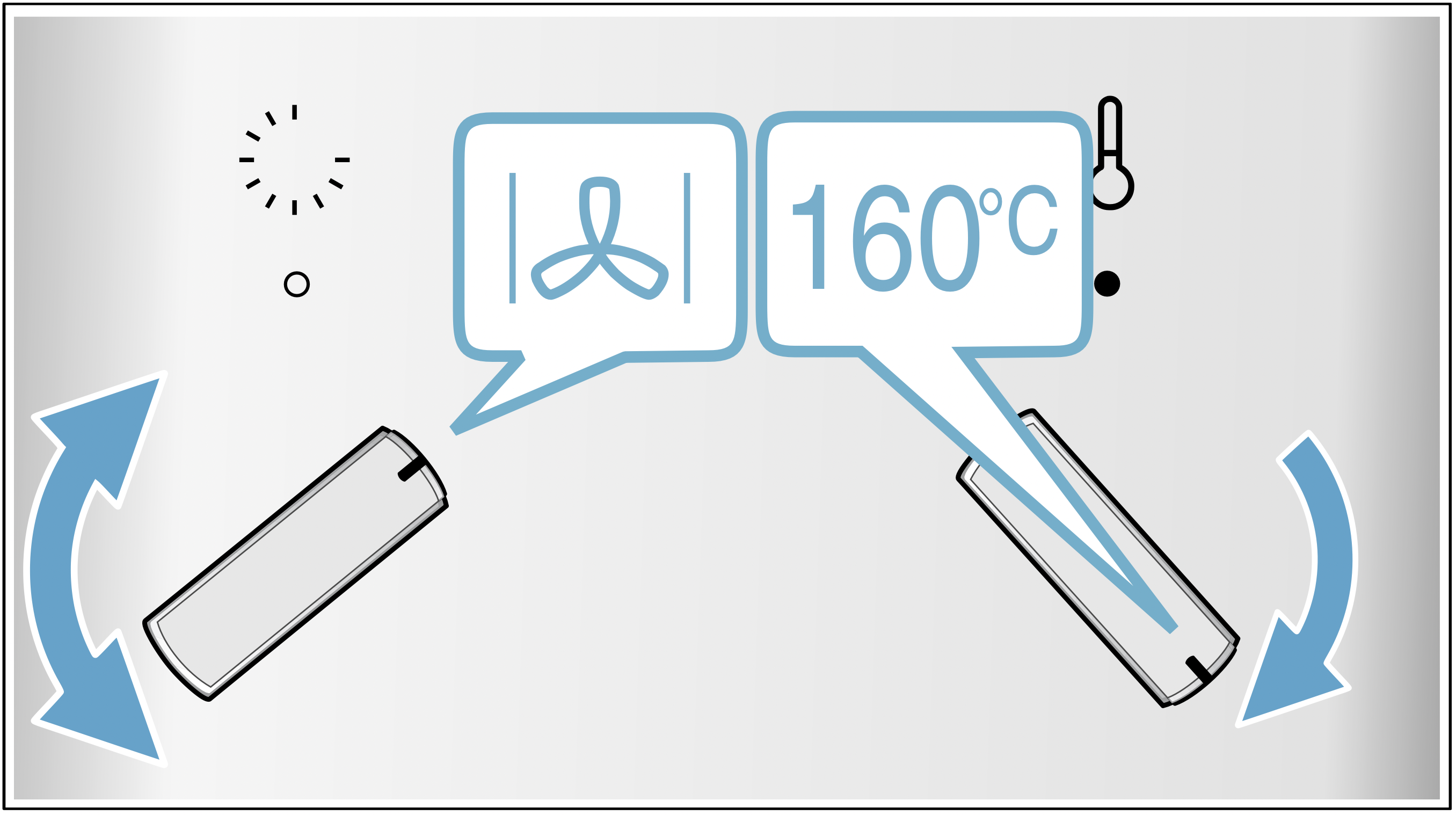
The appliance will start heating after a few seconds.
Once your food is cooked, turn the function selector to the "Off" position to switch the appliance off.
Note: You can also set a cooking time and end time on the appliance. "Time-setting options" on page 14
Changing
The heating function and temperature can be changed at any time using the relevant selector.
Heating-up indicator
The heating-up indicator will remain lit while the appliance is heating.
When you are preheating the appliance, the optimal time to place your food in the cooking compartment is when the heating-up indicator first goes out.
Note: Due to thermal inertia, the actual temperature inside the cooking compartment may differ slightly from the temperature that is displayed.
Rapid heating
With Rapid heating, you can shorten the heat-up time.
Only use rapid heating when a temperature of over 100 °C has been selected.
To achieve an even cooking result, do not place your food into the cooking compartment until rapid heating is complete.
- Set the function selector to
 .
. - Use the temperature selector to set a temperature of above 100 °C.
The oven starts to heat up after a few seconds. The ° symbol appears in the display. - Wait until a signal sounds and the
 symbol goes out.
symbol goes out.
The rapid heating has ended. - Place the meal in the cooking compartment.
- Set the type of heating.
Time-setting options
Your appliance has different time-setting options.

An audible signal sounds once the cooking time or timer duration has elapsed. You can cancel the audible signal early by pressing the  button.
button.
Note: You can change how long the audible signal sounds for in the basic settings. "Basic settings" on page 16
Note: If you have set a time-setting option, the time interval increases if you set a higher value. Example: You can set a cooking time of up to one hour in oneminute increments; for cooking times over one hour, you can set a cooking time in five-minute increments.
Setting the timer
The timer can be set when the appliance is switched on or off. It has its own audible signal so that you can tell whether it is the timer duration or a cooking time that has elapsed.
Tip: If the set timer duration is the duration for which you want to cook your food, use the cooking time. The appliance then switches off automatically.
- Press the
 button repeatedly until the
button repeatedly until the  symbol is selected.
symbol is selected. - Use the ( and) buttons to set the timer duration.
Default value for the ( button = 5 minutes
Default value for the ) button = 10 minutes
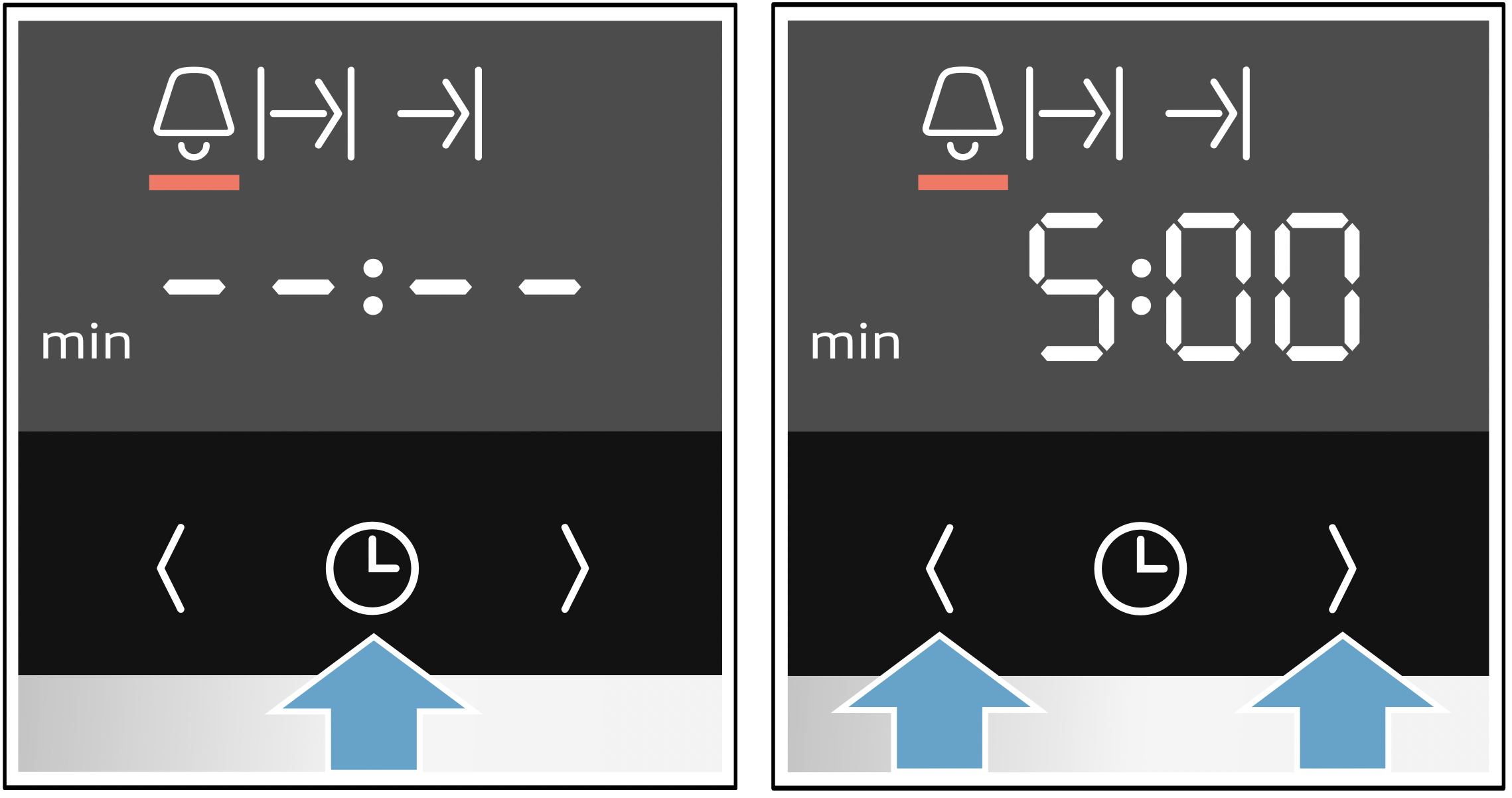
The setting is applied automatically. The timer duration starts to count down after a few seconds.
Note: When the set time has elapsed,  signal sounds. To end the timer, press the 0 button.
signal sounds. To end the timer, press the 0 button.
Setting the cooking time
Once the set cooking time has elapsed, the appliance switches off automatically. The function can only be used in combination with a type of heating.
- Set the heating type and temperature for the main oven
 .
. - Press the
 button repeatedly until the
button repeatedly until the  symbol is highlighted.
symbol is highlighted. - Use the ( and ) buttons to set the cooking time.
Default value for the ( button = 10 minutes
Default value for the )button = 30 minutes
The setting is applied automatically. The appliance starts to heat after a few seconds. The cooking time counts down in the display.
Once the cooking time has elapsed, an audible signal sounds and the appliance brings the operating mode to an end automatically.
To switch off, turn the function selector back to the "Off" position.
Setting the end time
You can delay the time at which cooking is due to finish. You can, for example, put your food in the cooking compartment in the morning and set the cooking time so that it is ready at lunch time.
Notes
- Ensure that food is not left in the cooking compartment for too long as it may spoil.
- Do not adjust the end time once the appliance is already in operation. Otherwise the cooking result would no longer be satisfactory.
- Place the food onto the appropriate accessory in the cooking compartment and close the appliance door.
- Set the heating type and temperature for the main oven
 .
. - Press the
 button repeatedly until the
button repeatedly until the  symbol is highlighted.
symbol is highlighted. - Use the ( and ) buttons to set the cooking time.
- Press the
 button repeatedly until the
button repeatedly until the  symbol is highlighted.
symbol is highlighted. - Use the ( and ) buttons to set the end time.
After a few seconds, the appliance will apply the settings. The end time is shown in the display. Once the appliance starts, the cooking time begins counting down.
As soon as the end time has been reached, an audible signal sounds and the appliance ends the operation automatically.
To switch off, turn the function selector back to the "Off" position.
Setting the time
You can only change the time when no other timesetting option is active and the function selector is at the "Off" position.
- Press the
 button repeatedly until the
button repeatedly until the  symbol is selected.
symbol is selected. - Use the ( or ) button to change the time.
The appliance applies the time after a few seconds.
Note: You can go to the basic settings to specify whether or not the time should be shown in the display.
Checking, changing or deleting settings
- Press the
 button repeatedly until the appropriate symbol is selected.
button repeatedly until the appropriate symbol is selected. - If required, use the ( or ) button to change the setting. To delete a time-setting option, set
 . The setting is applied automatically.
. The setting is applied automatically.
Childproof lock
The bottom oven has a childproof lock to prevent children from switching it on or changing settings by accident.
Notes
- If a hob is connected, it will not be affected by the childproof lock on the oven.
- After a power cut, the childproof lock will no longer be active.
Automatic childproof lock
The control panel for the main oven is locked so that the main oven cannot be switched on. To switch it on, the automatic childproof lock must be interrupted. After appliance operation, the control panel for the main oven is locked automatically.
To set or interrupt the automatic childproof lock, the function selector must be in the "Off" position.
Ensure that the childproof lock function is set in the basic settings. To do this, set  . "Basic settings" on page 16
. "Basic settings" on page 16
- Press and hold the
 button for approx. four seconds.
button for approx. four seconds.
 or
or  appears in the display.
appears in the display. - Use the ( or ) button to change the setting if necessary.
= childproof lock deactivated
= childproof lock activated - To confirm, press and hold the
 button again for approx. four seconds.
button again for approx. four seconds.
The basic setting will now be applied.
Interrupting
- Press and hold the
 button until the
button until the  symbol goes out in the display.
symbol goes out in the display. - Set the type of heating and temperature.
As soon as the main oven is switched off, the automatic childproof lock for the main oven is reactivated.
Basic settings
There are various settings available to you in order to help use your appliance effectively and simply. You can change these settings as required.
List of basic settings
Depending on the features of your appliance, not all basic settings will be available.
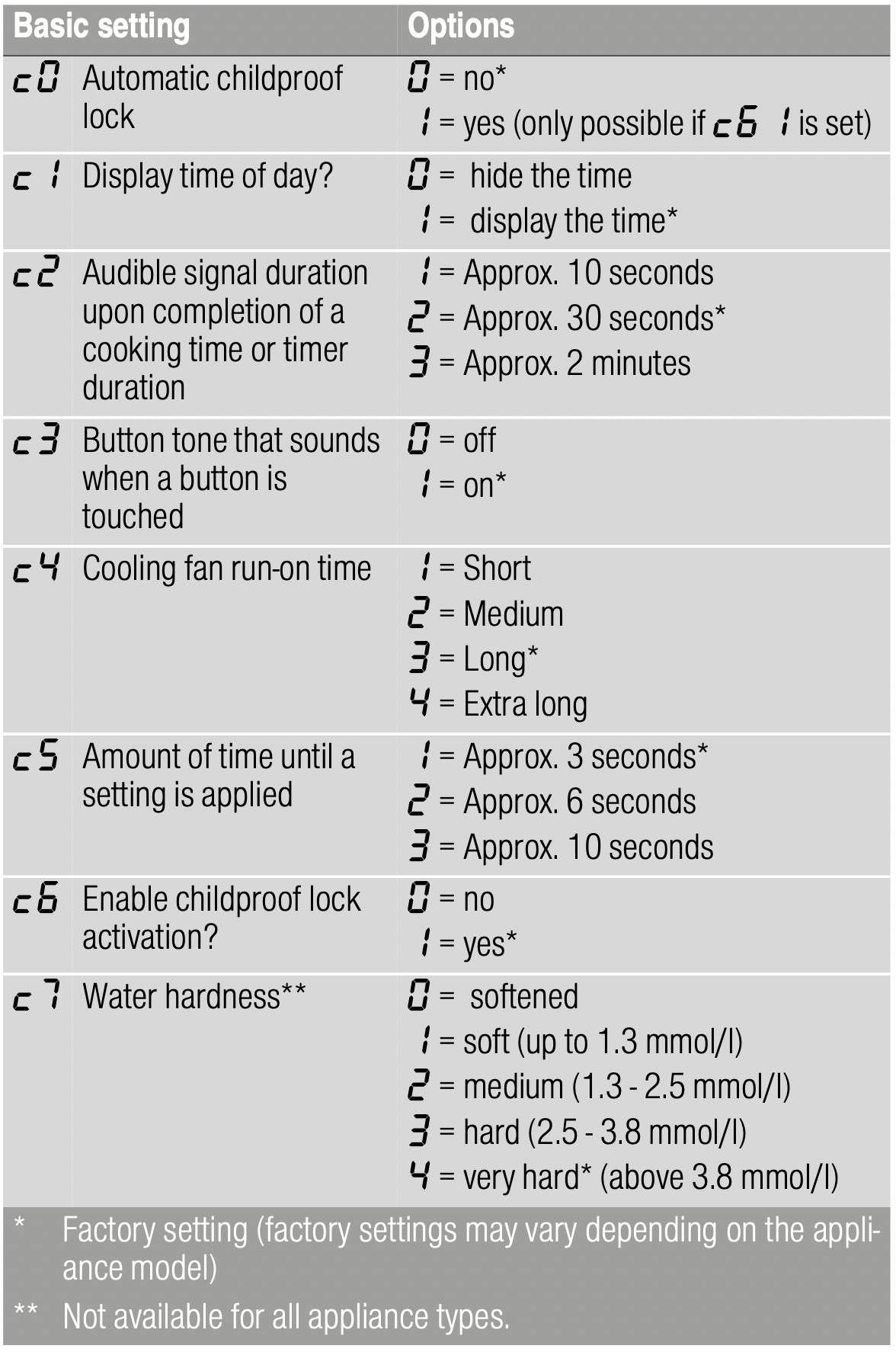
Changing the basic settings
The function selector must be set to the "Off" position.
- Press and hold the
 button for approx. four seconds.
button for approx. four seconds.
The first basic setting appears in the display, e.g.
- Use the ( or ) button to change the setting if necessary.
- Confirm by pressing the
 button.
button.
The next basic setting appears in the display. - Use the
 button to continue going through all of the basic settings as described above and to change the settings if necessary using the ( or ) button.
button to continue going through all of the basic settings as described above and to change the settings if necessary using the ( or ) button. - To confirm, press and hold the
 button again for approx. four seconds.
button again for approx. four seconds.
All basic settings have now been applied.
You can change the basic settings again at any time.
Note: Following a power failure, the basic factory settings are restored.
Cleaning agent
With good care and cleaning, your appliance will retain its appearance and remain fully functioning for a long time to come. We will explain here how you should correctly care for and clean your appliance.
Suitable cleaning agents
To ensure that the different surfaces are not damaged by using the wrong cleaning agent, observe the information in the table. Depending on the appliance model, not all of the areas listed may be on/in your appliance.
Caution! Risk of surface damage
Do not use:
- Harsh or abrasive cleaning agents,
- Cleaning agents with a high alcohol content,
- Hard scouring pads or cleaning sponges,
- High-pressure cleaners or steam cleaners,
- Special cleaners for cleaning the appliance while it is hot.
Wash new sponge cloths thoroughly before use.
Tip: Highly recommended cleaning and care products can be purchased through the after-sales service. Observe the respective manufacturer's instructions.
Warning – Risk of burns! The appliance becomes very hot. Never touch the interior surfaces of the cooking compartment or the heating elements. Always allow the appliance to cool down. Keep children at a safe distance.
|
Area |
Cleaning |
|
Appliance exterior |
|
|
Stainless steel front |
Hot soapy water: Clean with a dish cloth and then dry with a soft cloth. Remove flecks of lime scale, grease, starch and albumin (e.g. egg white) immediately. Corrosion can form under such flecks. Special stainless steel cleaning products suitable for hot surfaces are available from our after-sales service or from specialist retailers. Apply a very thin layer of the cleaning product with a soft cloth. |
|
Plastic |
Hot soapy water: Clean with a dish cloth and then dry with a soft cloth. Do not use glass cleaner or a glass scraper. |
|
Painted surfaces |
Hot soapy water: Clean with a dish cloth and then dry with a soft cloth. |
|
Control panel |
Hot soapy water: Clean with a dish cloth and then dry with a soft cloth. Do not use glass cleaner or a glass scraper. |
|
Door panels |
Hot soapy water: Clean with a dish cloth and then dry with a soft cloth. Do not use a glass scraper or a stainless steel scouring pad. |
|
Door handle |
Hot soapy water: Clean with a dish cloth and then dry with a soft cloth. If descaler comes into contact with the door handle, wipe it off immediately. Otherwise, any stains will not be able to be removed. |
|
Appliance interior |
|
|
Enamelled surfaces |
Hot soapy water or a vinegar solution: Clean with a dish cloth and then dry with a soft cloth. Soften baked-on food remnants with a damp cloth and soapy water. Use stainless steel wire wool or oven cleaner to remove stubborn dirt. Caution! Never use oven cleaner in the cooking compartment when it is still warm. This may damage the enamel. Remove all food remnants from the cooking compartment and the appliance door before you next heat up the appliance. Leave the cooking compartment open to dry after cleaning it. It is best to use the cleaning function. "Cleaning function" on page 19 Note: Food residues can cause white deposits to form. These are harmless and do not affect how the appliance works. Remove using lemon juice if required. |
|
Glass cover for the interior lighting |
Hot soapy water: Clean with a dish cloth and then dry with a soft cloth. If the cooking compartment is heavily soiled, use oven cleaner. |
|
Door seal Do not remove. |
Hot soapy water: Clean with a dish cloth. Do not scour. |
|
Door cover |
made from stainless steel: Use stainless steel cleaner. Follow the manufacturers' instructions. Do not use stainless steel care products. made from plastic: Clean using hot soapy water and a dish cloth. Dry with a soft cloth. Do not use glass cleaner or a glass scraper. Remove the door cover for cleaning. |
|
Rails |
Hot soapy water: Soak and clean with a dish cloth or brush. |
|
Pull-out system |
Hot soapy water: Clean with a dish cloth or a brush. Do not remove the lubricant while the pull-out rails are pulled out – it is best to clean them when they are pushed in. Do not clean in the dishwasher. |
|
Accessories |
Hot soapy water: Soak and clean with a dish cloth or brush. If there are heavy deposits of dirt, use a stainless steel scouring pad. |
Notes
- Slight differences in colour on the front of the appliance are caused by the use of different materials, such as glass, plastic and metal.
- Shadows on the door panels, which look like streaks, are caused by reflections made by the interior lighting.
- Enamel is baked on at very high temperatures.This can cause some slight colour variation. This is normal and does not affect operation.
The edges of thin trays cannot be completely enamelled. As a result, these edges can be rough. This does not impair the anti-corrosion protection.
Keeping the appliance clean
Always keep the appliance clean and remove dirt immediately so that stubborn deposits of dirt do not build up.
Warning – Risk of fire! Loose food remnants, fat and meat juices may catch fire. Before using the appliance, remove the worst of the food remnants from the cooking compartment, heating elements and accessories.
Tips
- Clean the cooking compartment after each use. This will ensure that dirt cannot be baked on.
- Always remove flecks of limescale, grease, starch and albumin (e.g. egg white) immediately.
- Use the universal pan for baking very moist cakes.
- Use suitable ovenware for roasting, e.g. a roasting dish.
Cleaning function
Your appliance comes with the EasyClean cleaning aid. The EasyClean cleaning aid makes it easier to clean the cooking compartment.
EasyClean
The EasyClean cleaning aid makes it easier to clean the cooking compartment. Dirt is softened beforehand by vaporizing soapy water. It can then be removed more easily.
Warning – Risk of scalding! Water in a hot cooking compartment may create hot steam. Never pour water into the cooking compartment when the cooking compartment is hot.
Setting the cleaning aid
Note: Only use the EasyClean  cleaning aid when the cooking compartment has cooled down. Allow the cooking compartment to completely cool down.
cleaning aid when the cooking compartment has cooled down. Allow the cooking compartment to completely cool down.
- Remove the accessories from the cooking compartment.
- Mix 0.4 litres water (not distilled water) with a drop of washing-up liquid and pour into the middle of the cooking compartment floor.
- Use the function selector and temperature selector to set EasyClean
 .
.
The duration is shown in the display.
The cleaning aid starts after a few seconds. The duration counts down in the display.
Notes
- The duration is preset and cannot be changed.
- The end time cannot be delayed.
If œ flashes in the display after switching on, the cooking compartment has not cooled completely. Switch off the appliance. Wait until  appears in the display and switch the cleaning aid on again.
appears in the display and switch the cleaning aid on again.
Once the cleaning aid has run through to the end, an audible signal sounds.
Subsequent cleaning
The remaining water in the cooking compartment must be removed promptly. Do not leave the remaining water in the cooking compartment for an extended period (e.g. overnight). The appliance must not be operated when the cooking compartment is still wet or damp.
- Open the appliance door and remove the remaining water with an absorbent sponge cloth.
- Clean the smooth surfaces in the cooking compartment with a dish cloth or a soft brush. Stubborn residues can be removed using a stainless steel scouring pad.
- Remove limescale with a cloth soaked in vinegar.
Then wipe with clean water and rub dry with a soft cloth (including under the door seal). - To switch off, turn the function selector to the "Off" position.
- Leave the appliance door ajar in the stop position (approx. 30°) for approx. one hour to allow the enamel surfaces in the cooking compartment to dry thoroughly. Alternatively, you can also run the rapid drying function for the cooking compartment.
Running the rapid drying function for the cooking compartment
- After the cleaning aid has been run through, leave the appliance door ajar in the stop position (approx. 30°).
- Start CircoTherm hot air with 50 °C.
- After five minutes, switch off the appliance and close the appliance door.
Removing heavy deposits of dirt
You have several options for removing particularly stubborn deposits of dirt.
- Leave the soapy water to work for some time before starting the cleaning aid.
- Rub soapy water onto the dirt on the smooth surfaces before starting the cleaning aid.
- Repeat the cleaning aid after the cooking compartment has cooled down.
Rails
With good care and cleaning, your appliance will retain its appearance and remain fully functional for a long time to come. This will tell you how to remove the shelves and clean them.
Detaching and refitting the rails
Warning – Risk of burns! The rails become very hot. Never touch the hot rails. Always allow the appliance to cool down. Keep children away from the appliance.
Detaching the rails
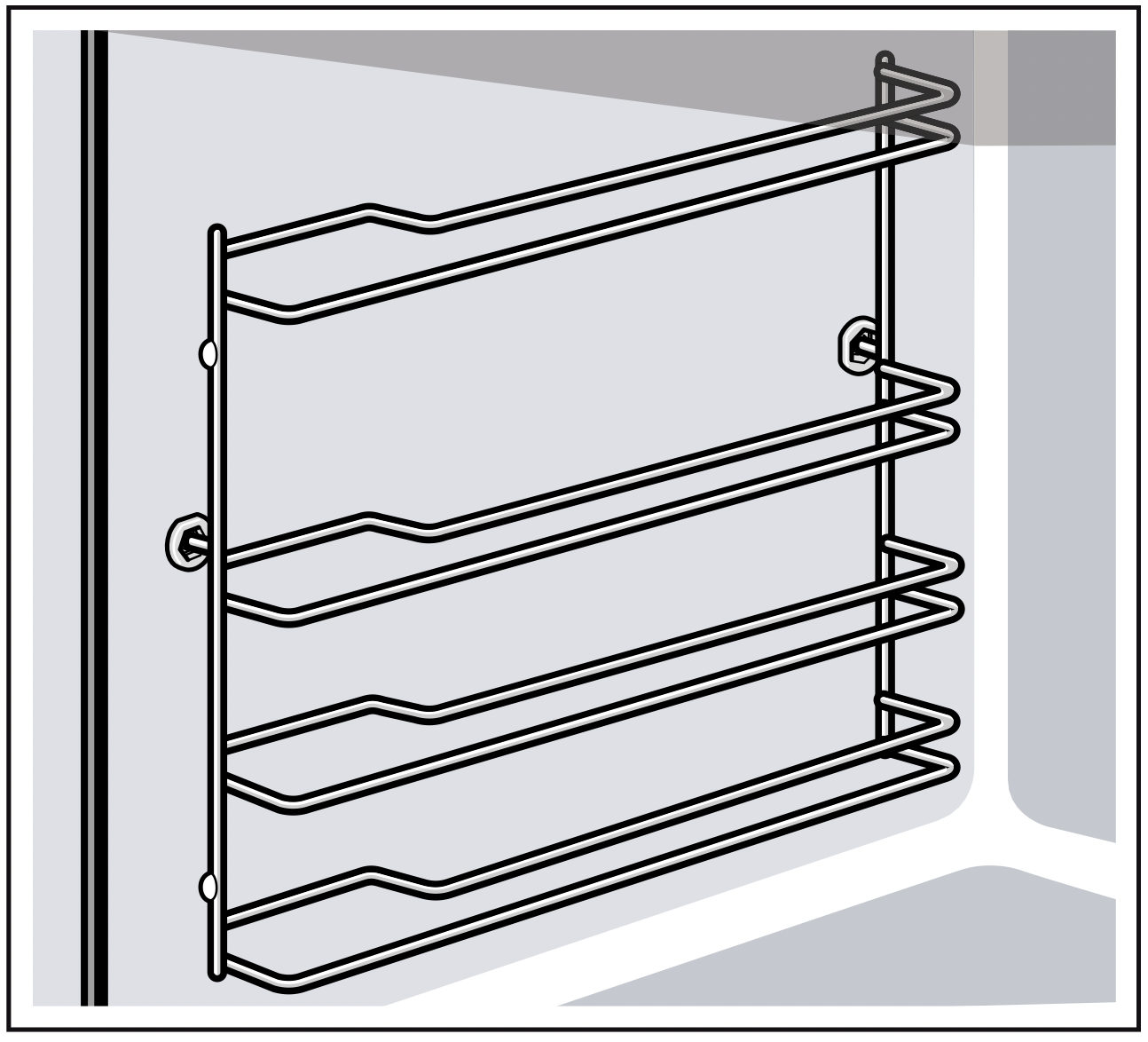
- Lift the rail slightly at the front a and detach it b (fig. 1)
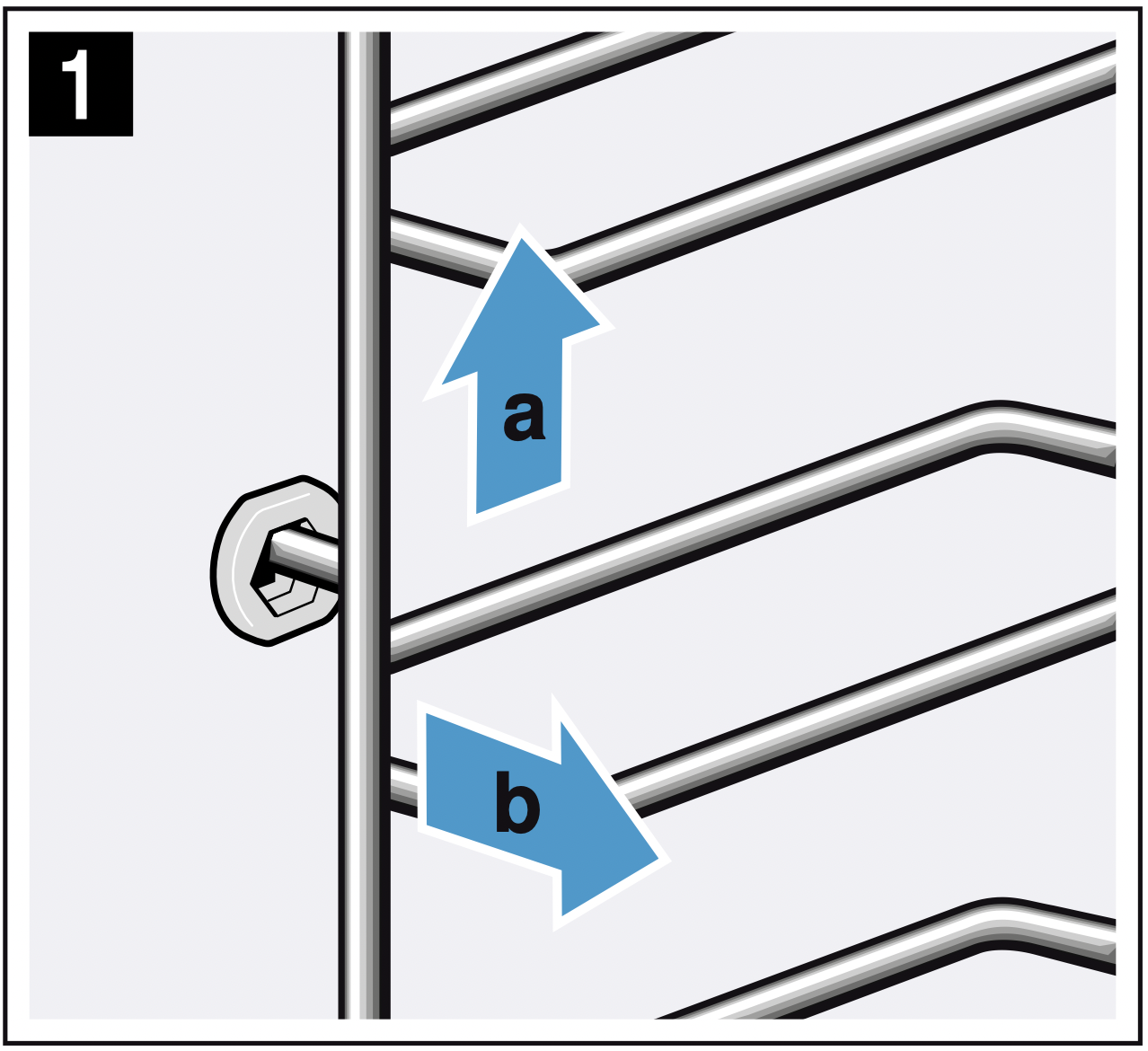
- Then pull the whole rail to the front and remove it (fig. 2).
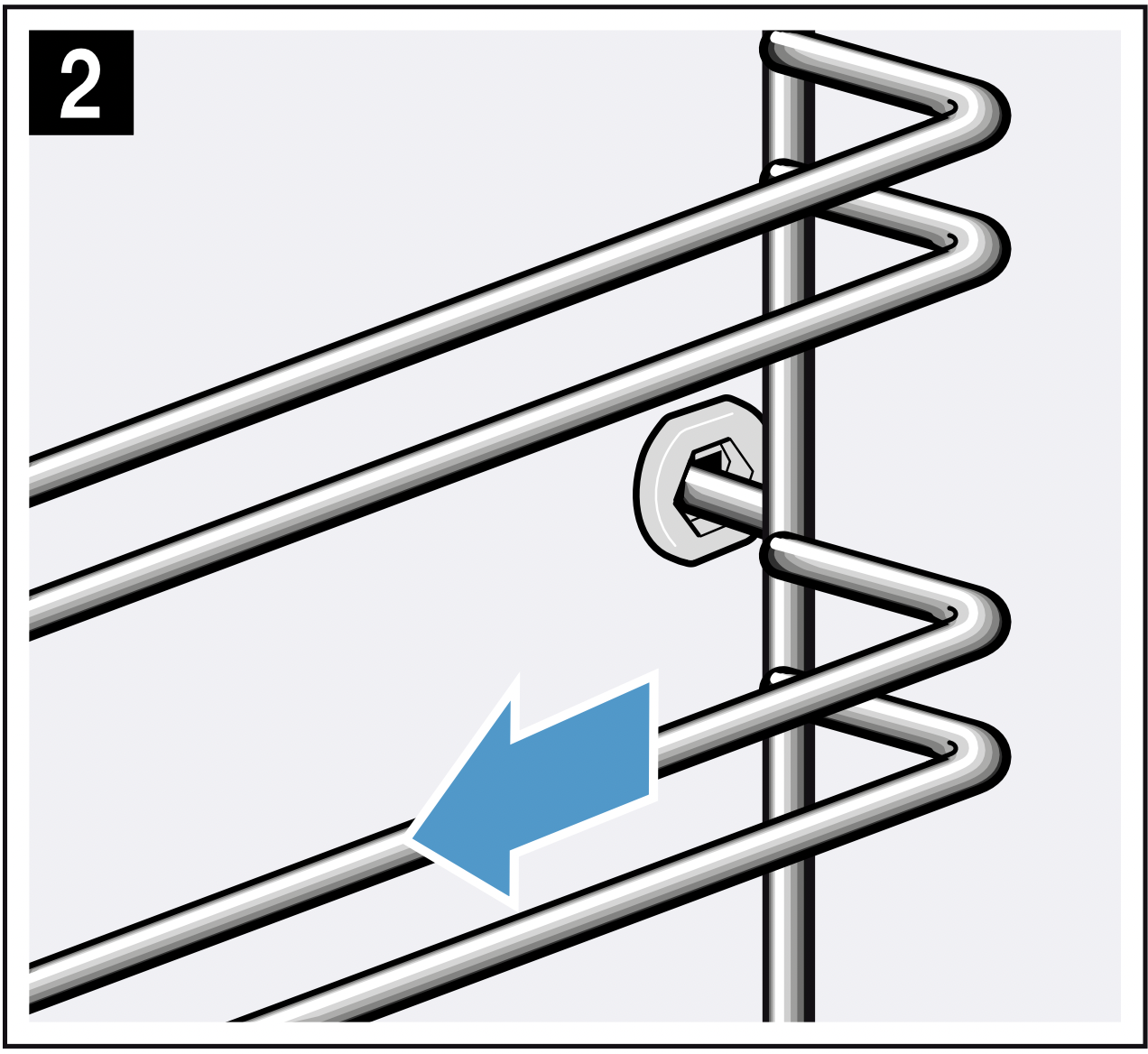
Clean the rails with cleaning agent and a sponge. For stubborn dirt deposits, use a brush.
Attaching the rails
The rails only fit on the right or the left side. For both rails, ensure that the curved rods are at the front.
- First, insert the rail in the middle of the rear socket a, until the rail rests against the cooking compartment wall, and push it back b (figure 1).
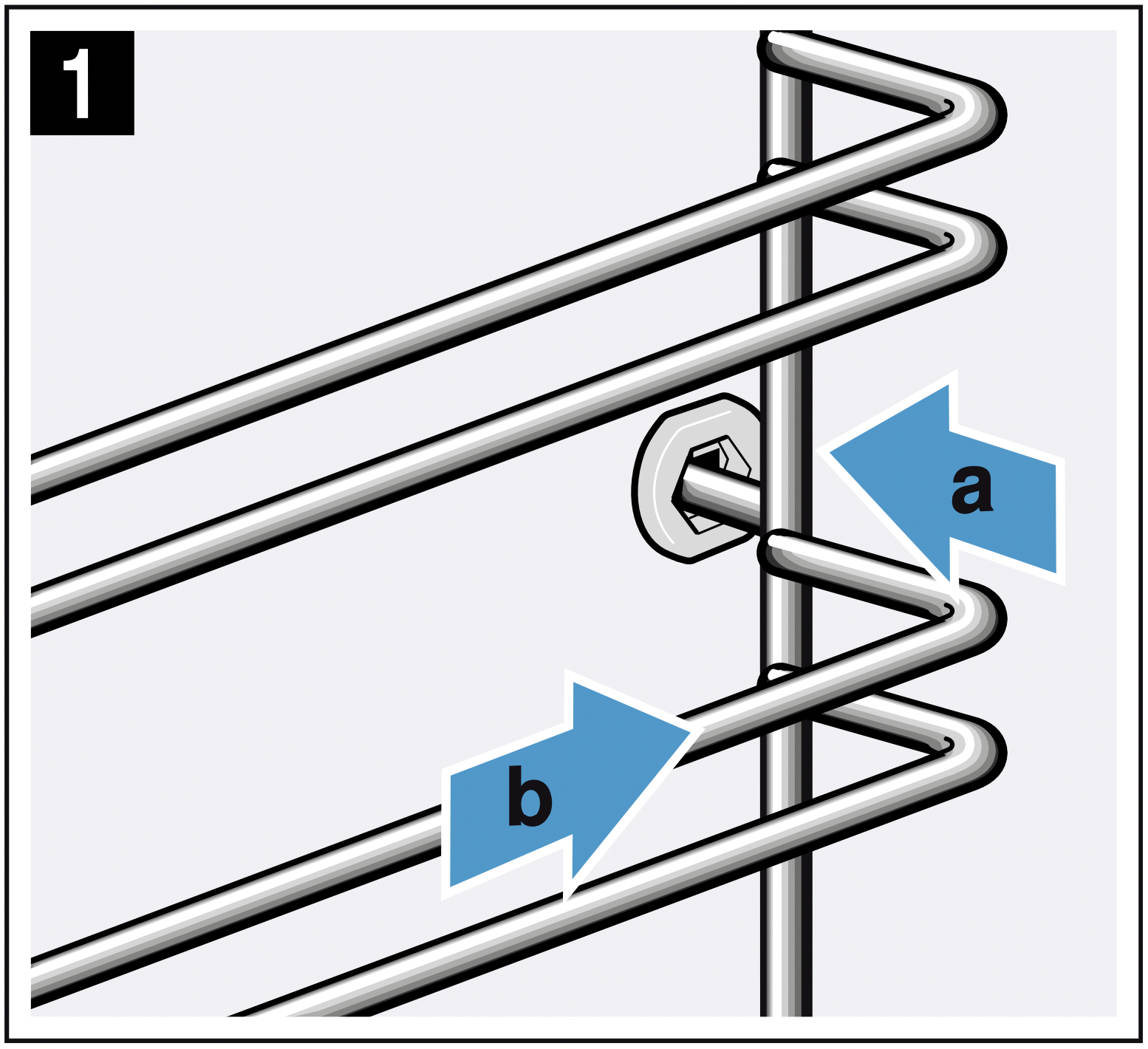
- Then insert the rail into the front socket c, until the rail also rests against the cooking compartment wall here, and press it downward d (figure 2).
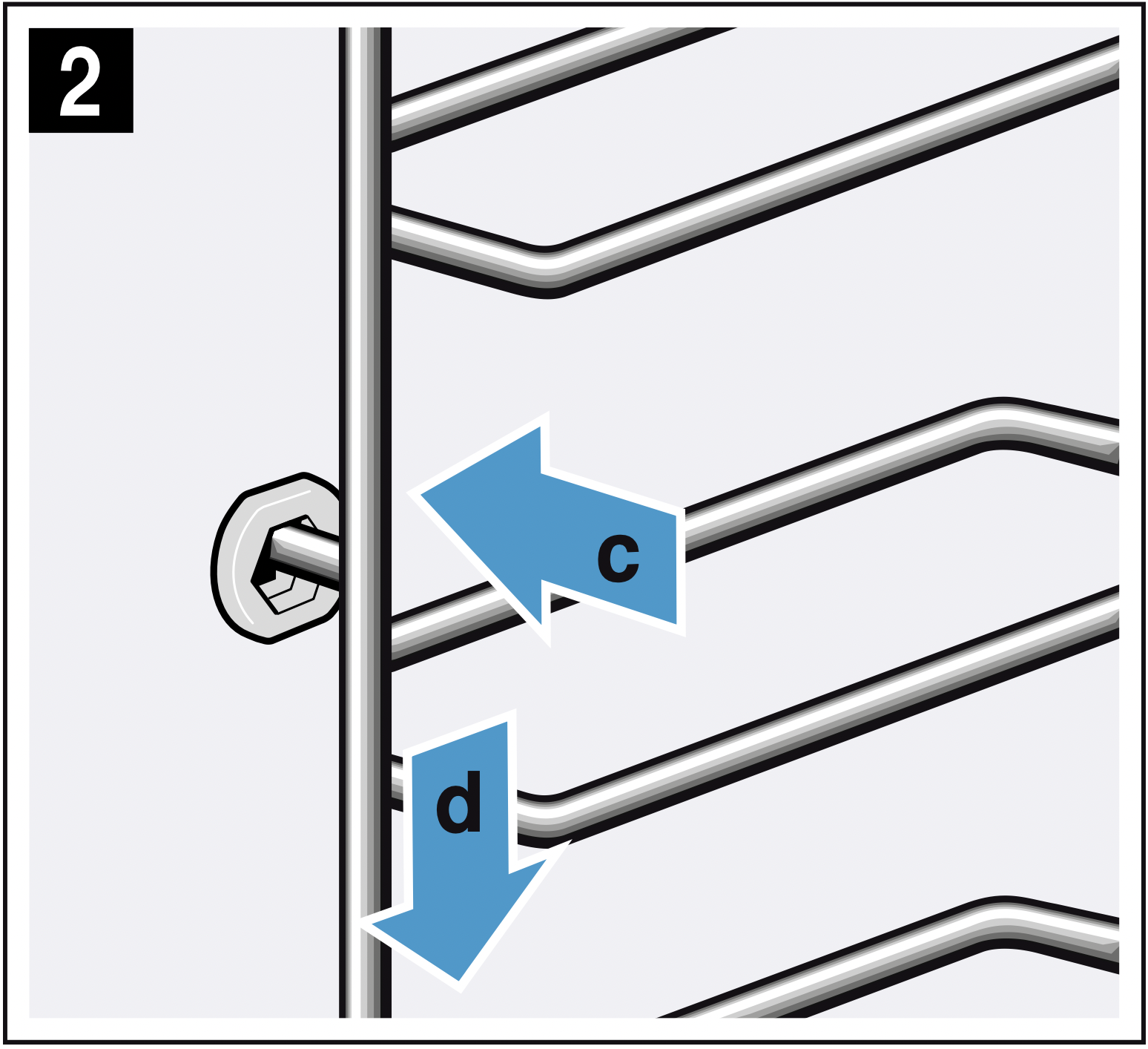
Detaching and refitting the rails
Warning – Risk of burns! The rails become very hot. Never touch the hot rails. Always allow the appliance to cool down. Keep children away from the appliance.
Detaching the shelf supports
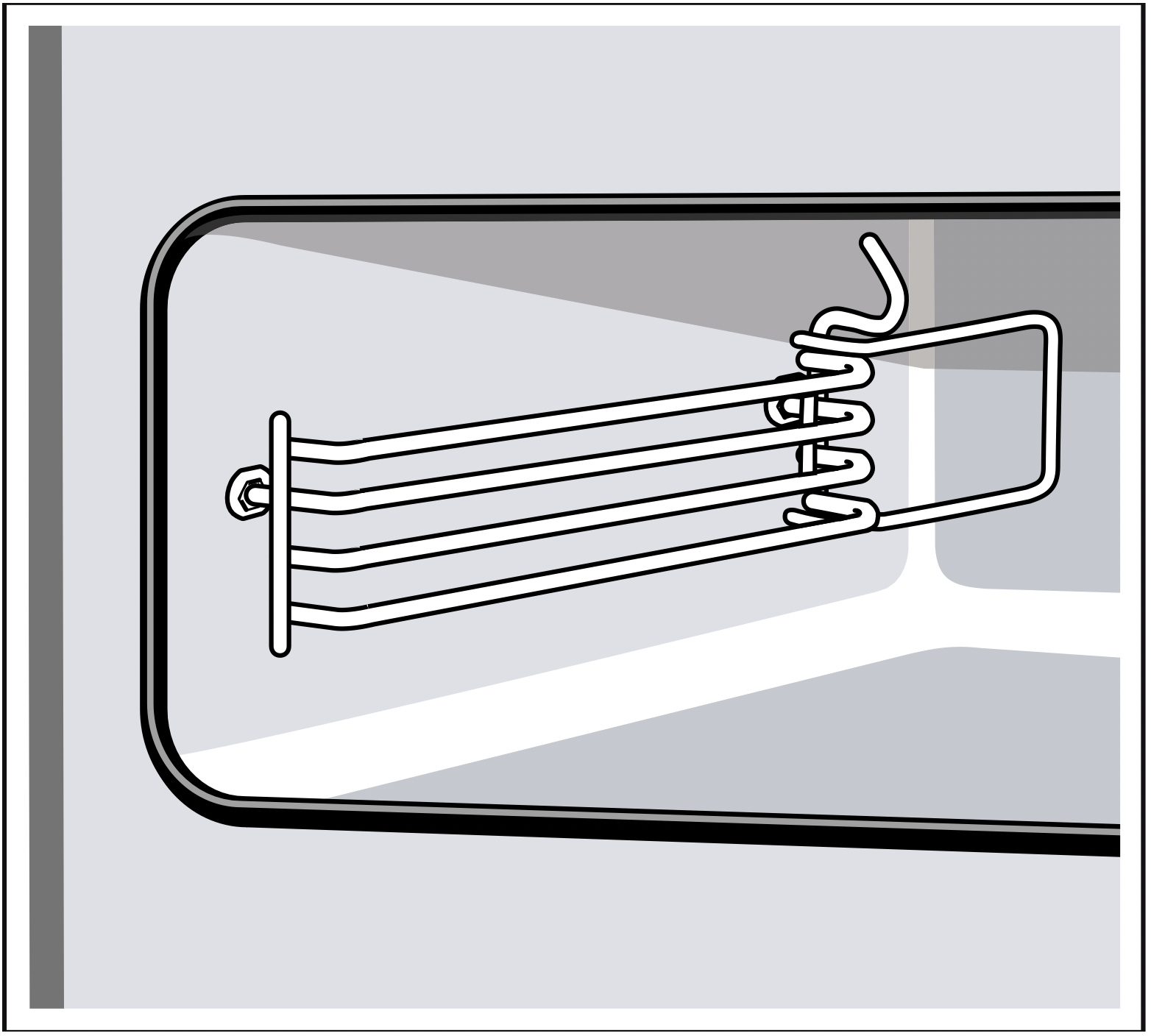
- Lift the shelf support slightly at the front a and detach it b (fig. 1).
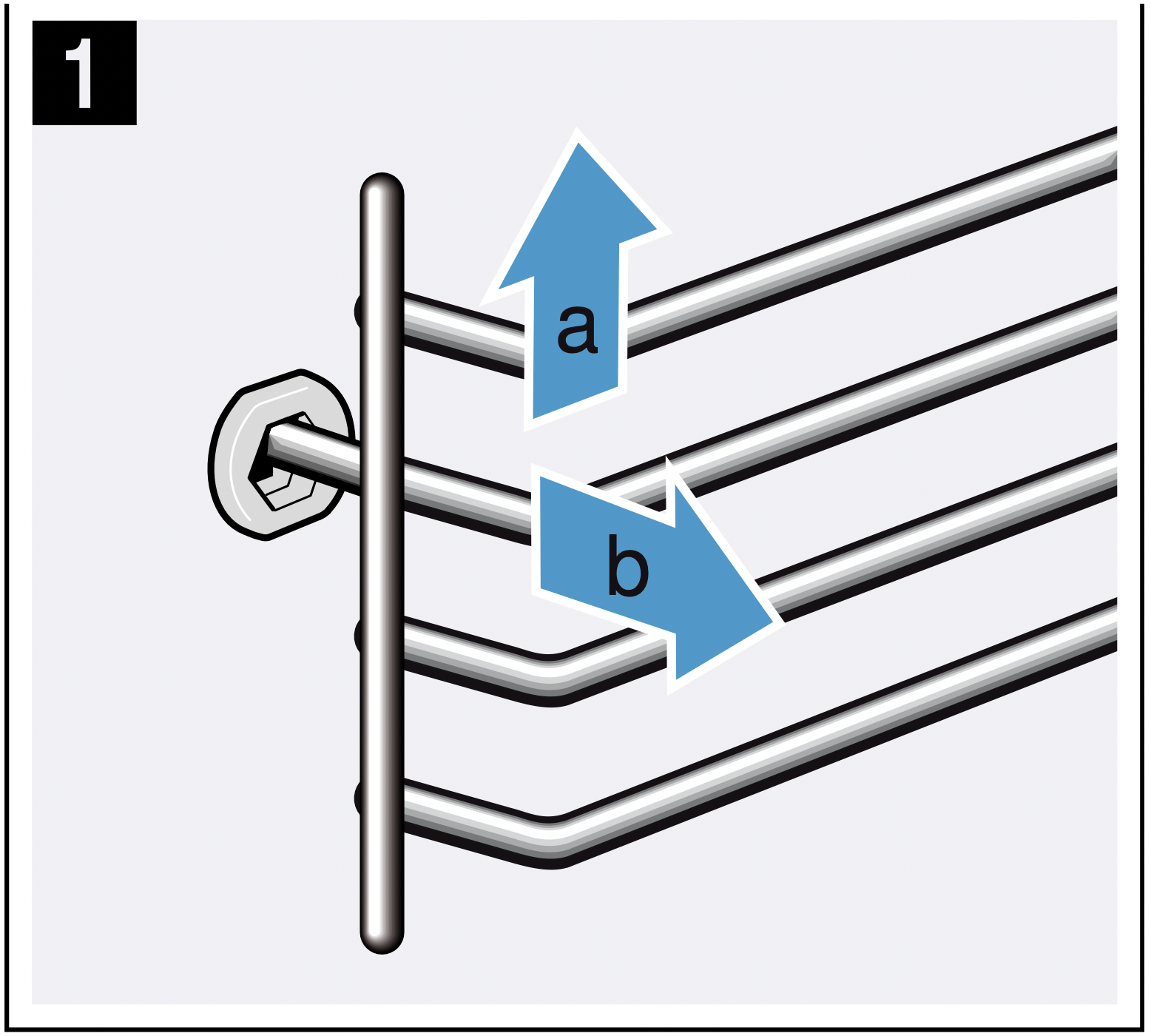
- Then pull the whole shelf support towards you and remove it (fig. 2).
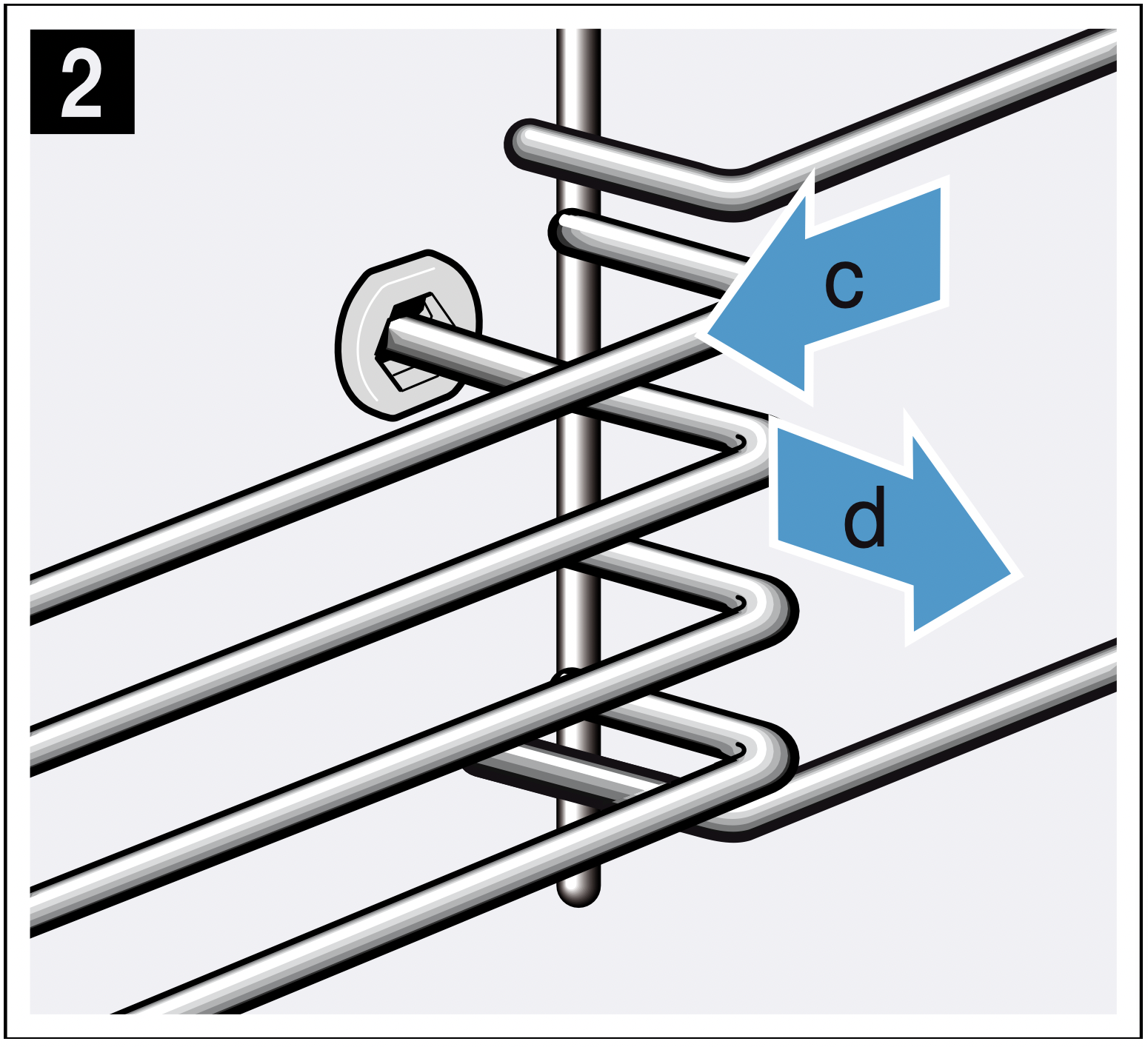
Clean the shelf supports with washing-up liquid and a sponge. For stubborn dirt deposits, use a brush.
Refitting the shelf supports
The shelf supports are designed to fit on either the rightor the left-hand side (not both).For each of the shelf supports, make sure that the hooks at the back are at the top.
- First, push the shelf support into the middle of the rear socket ‚a until the shelf support rests against the cooking compartment wall, and then push it back b (fig. 1).
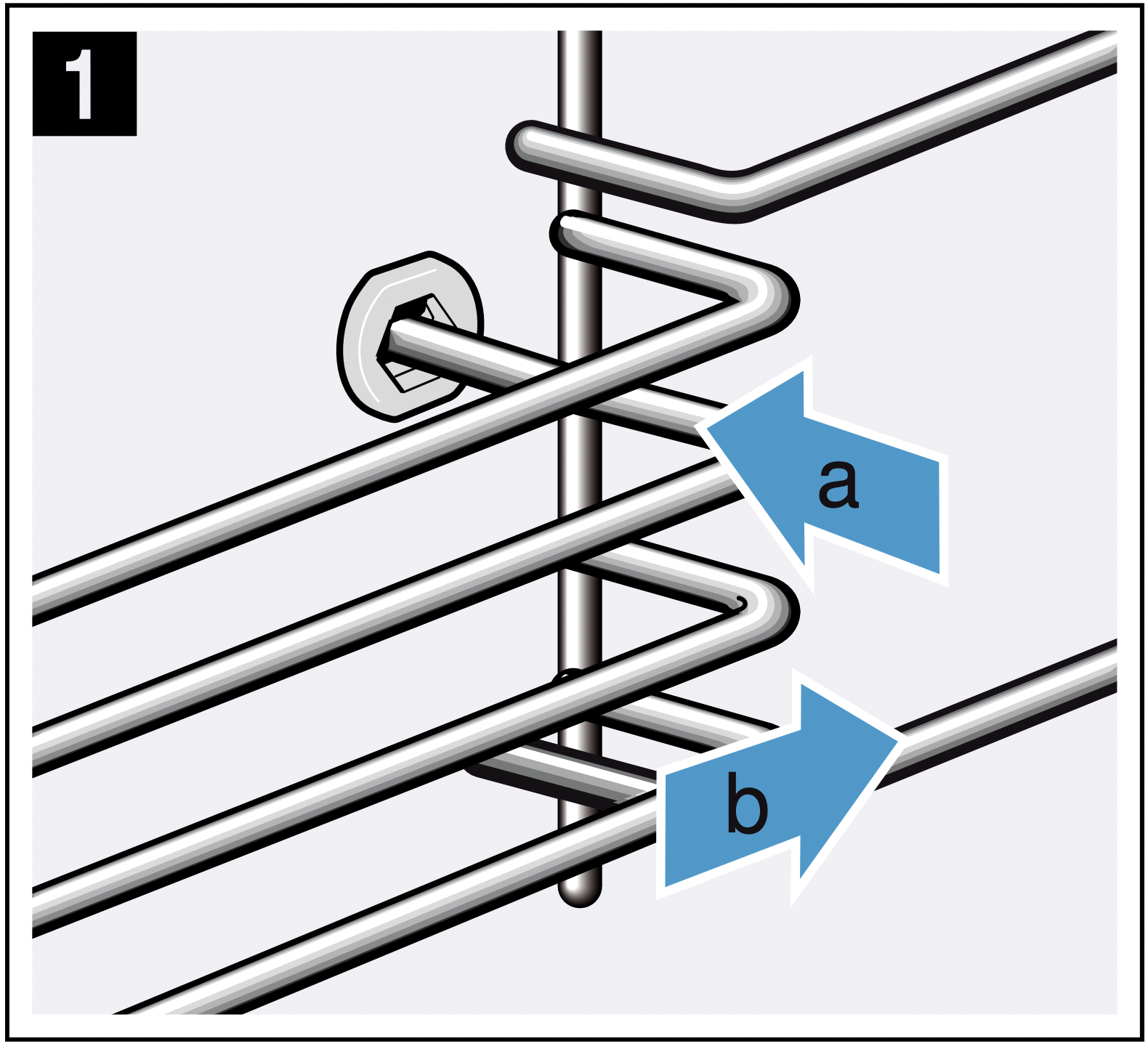
- Then push the shelf support into the front socket c, until the shelf support also rests against the cooking compartment wall, and then press it downwards d (fig. 2).
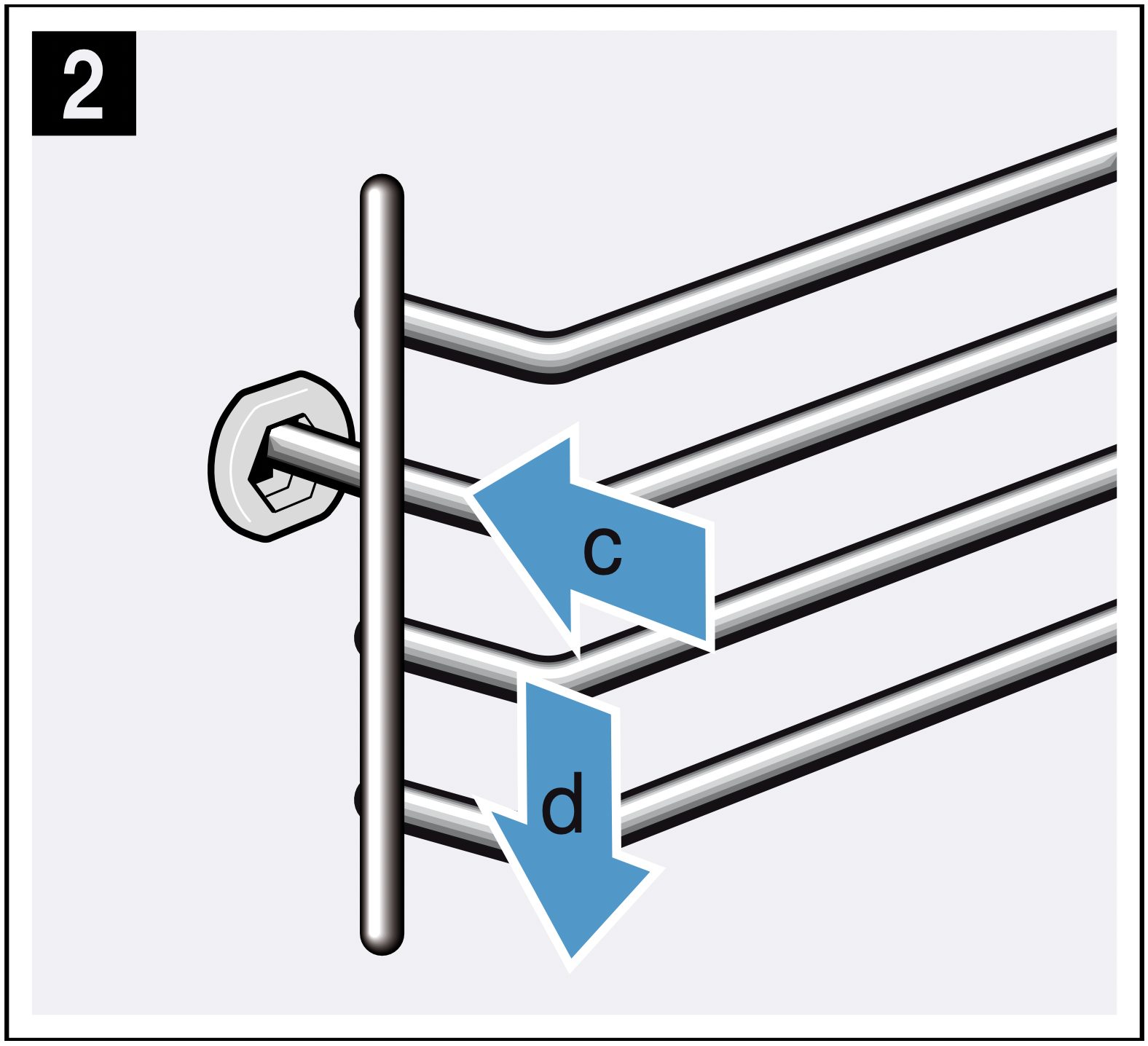
Fitting and removing the pull-out rails
On appliance models with shelf supports, you must change the basic settings to "Telescopic rails: Yes".For more information, refer to the "Basic settings" section. Page 16
If necessary, you can use pull-out rails on all levels.
If your appliance features the EcoClean Direct cleaning function, you will need to take the entire shelf supports for fitting and removing the pull-out rails out of the cooking compartment. Otherwise, the EcoClean Direct coating may be damaged.
If your appliance features the pyrolytic self-cleaning function, you will need to take the pull-out rails out of the cooking compartment before running the cleaning function.The pull-out rails are not suitable for pyrolytic self-cleaning.
Notes
- Only use the pull-out rails in conjunction with the universal pan, baking tray, wire rack and accessories that are placed on the wire rack. All other accessories are unsuitable.
- The pull-out rails are not suitable for appliances with a microwave function.
Warning – Risk of burns! The rails become very hot. Never touch the hot rails. Always allow the appliance to cool down. Keep children away from the appliance.
Removing the pull-out rails
- Push on the tab marked "PUSH" behind the end of the rail, and push the rail away from you (fig. 1).

- Keep the "PUSH" tab pushed back and swing the rail out (fig. 2).
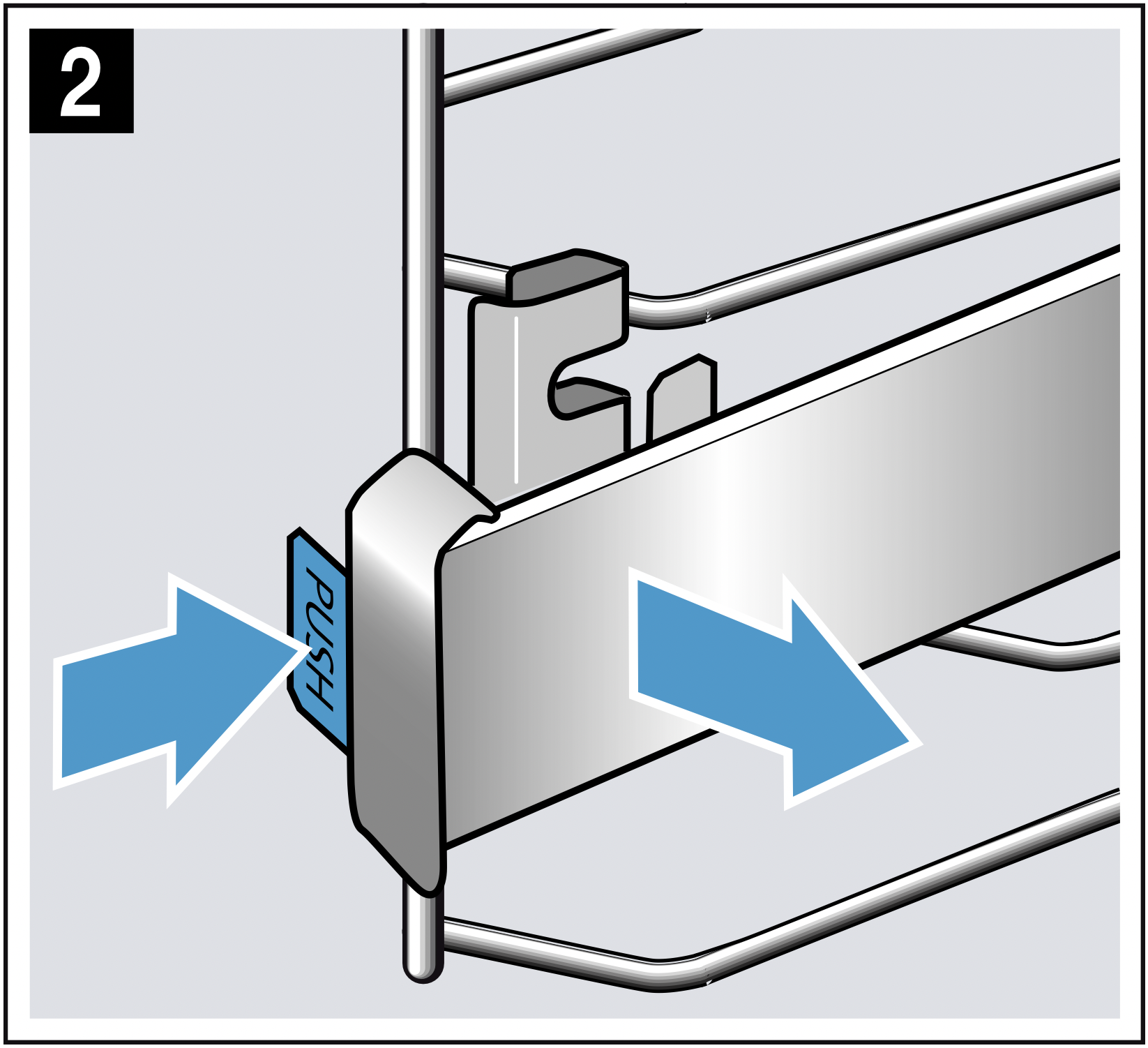
- Pull the rail out towards you until the retainer at the back unhooks (fig. 3).
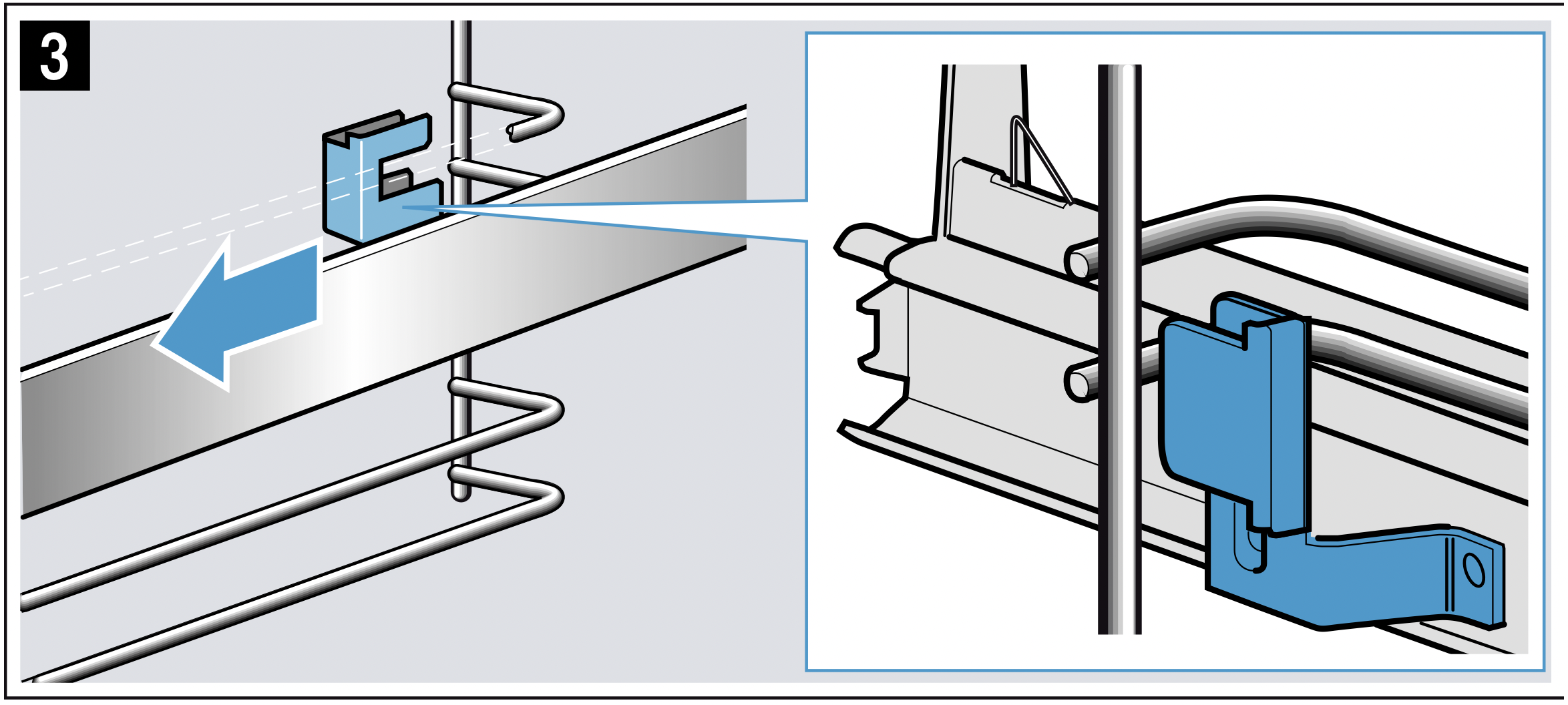
- Remove the pull-out rail (fig. 4).

Use washing-up liquid and a sponge to clean the pullout rails. For stubborn dirt deposits, use a brush.
Fitting the pull-out rails
The rails are designed to fit on either the right- or the left-hand side (not both).Make sure when you fit them that you can pull them out towards you.
- The rail must sit between the two bars (fig. 1).
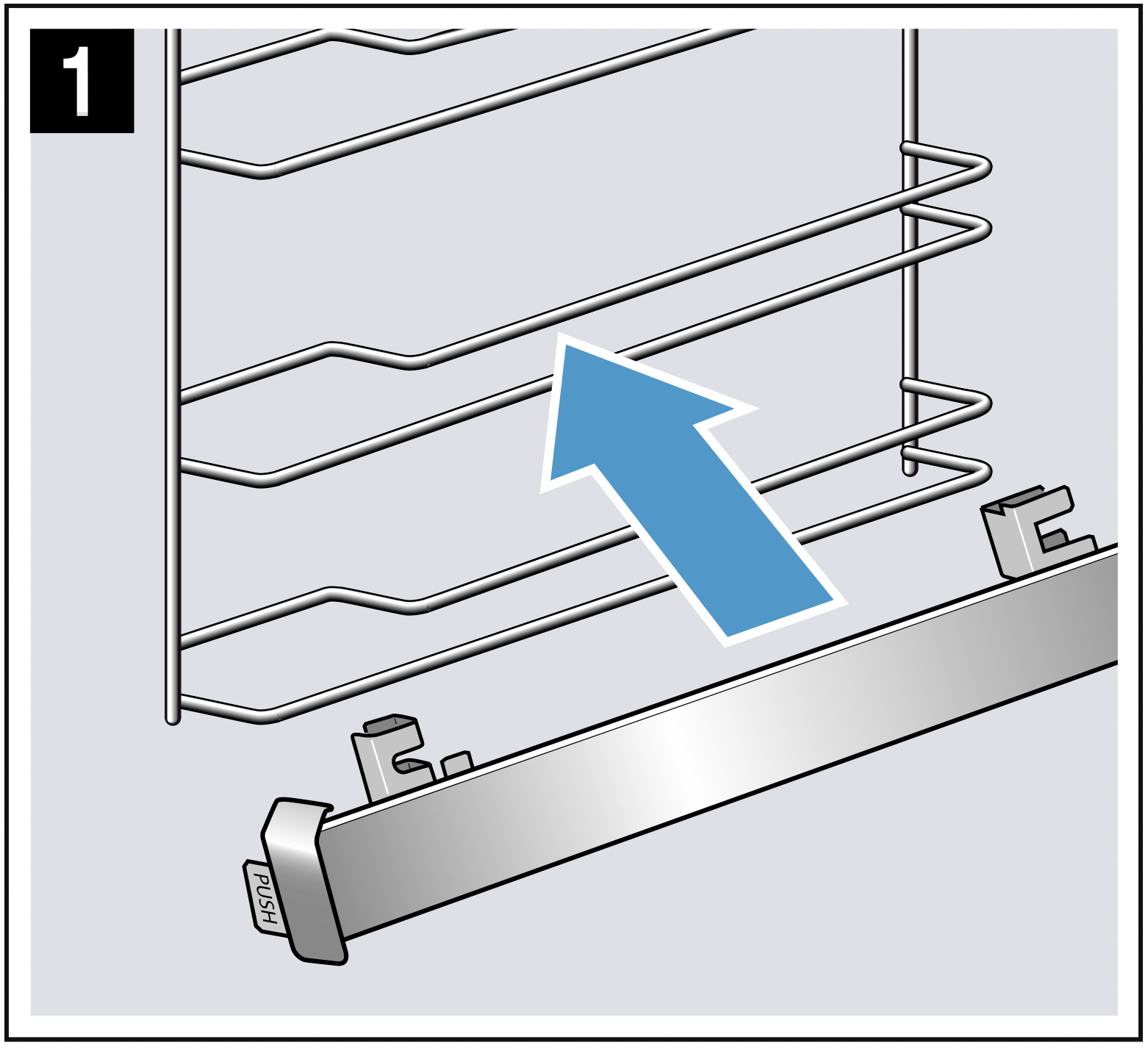
- Push the retainer at the back in between the lower and the upper bar (fig. 2).
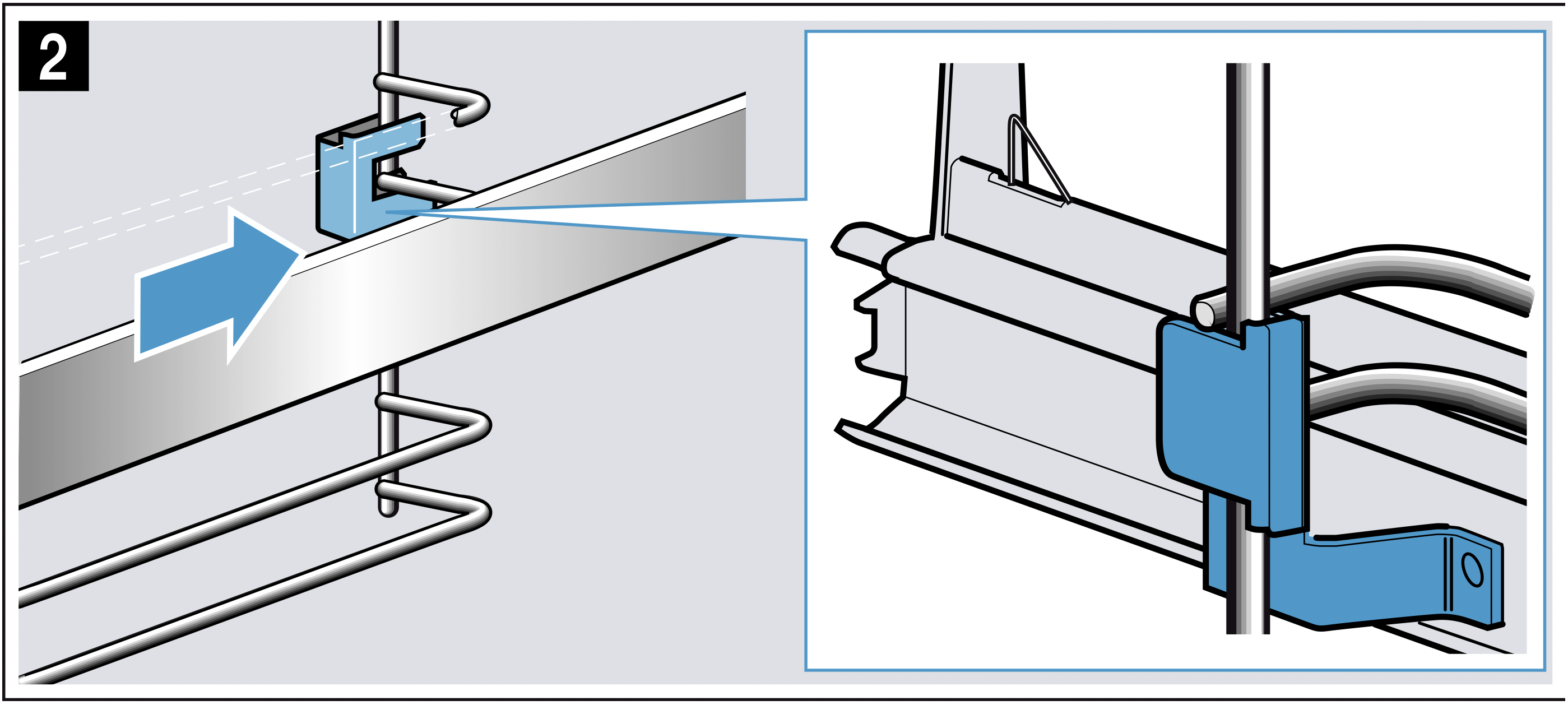
- Push on the "PUSH" tab and swing the rail in so that the retainer ends up between the two bars (fig. 3).

- Release the "PUSH" tab; the retainer will hook into place (fig. 4). Then pull the rail out as far as it will go and slide it back in.

Appliance door
With good care and cleaning, your appliance will retain its appearance and remain fully functional for a long time to come. This will tell you how to clean the appliance door.
Main oven – Fitting and removing the glass panels
To facilitate cleaning, you can remove the glass panels from the appliance door.
Locking the appliance door
- Open the appliance door fully.
- Open the two locking levers on the left and right (fig. 1).
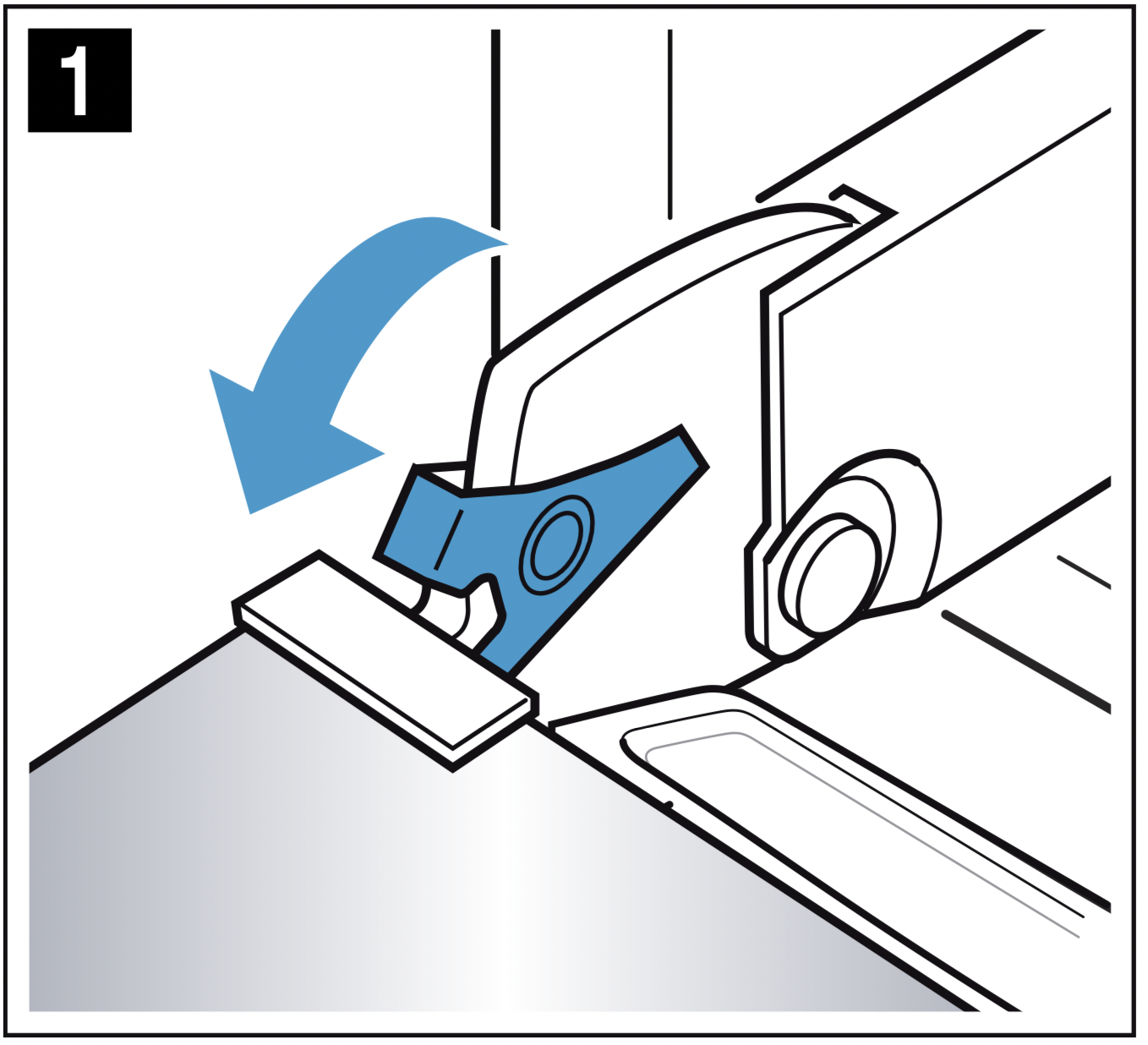
- Close the appliance door as far as it goes (fig. 2).
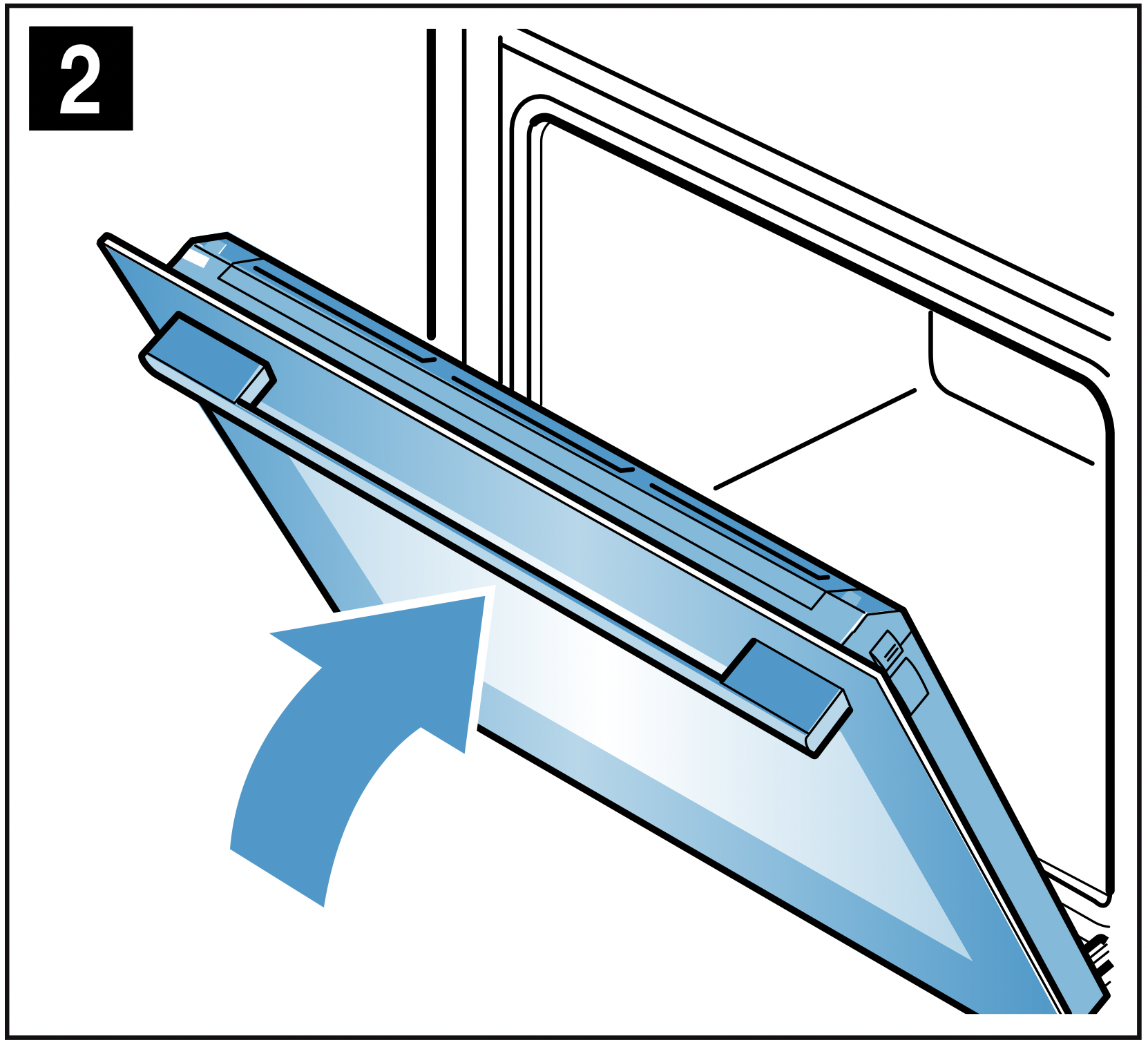
Removing panels
- Press the left- and right-hand sides of the cover (fig. 1).

- Remove the cover (fig. 2).

- Lift out each panel (fig. 3) and set them down carefully on a flat surface.
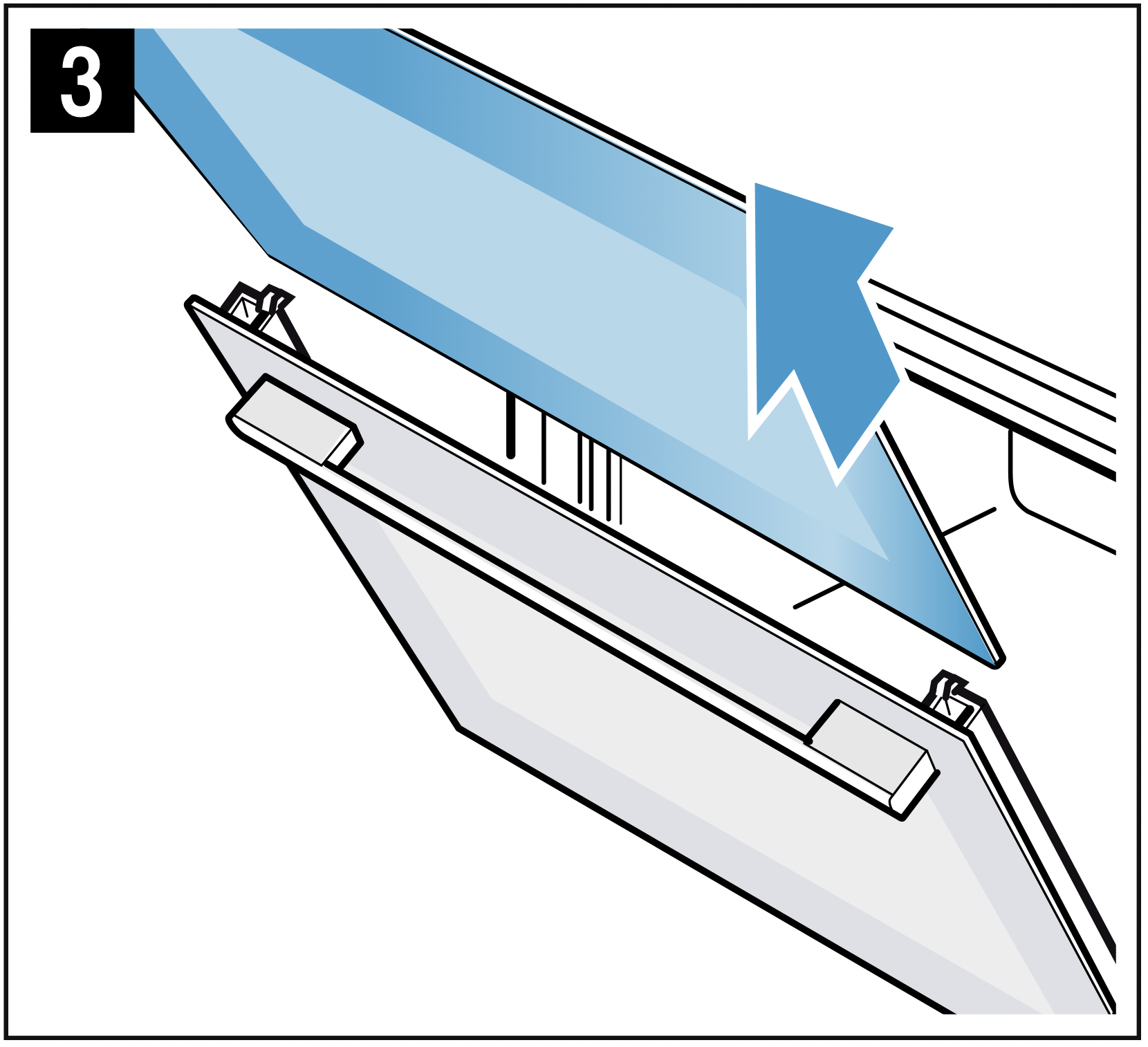
- If necessary, you can remove the condensate trough for cleaning. To do this, open the appliance door fully (fig. 4).

- Tilt the condensate trough up and remove it (fig. 5).
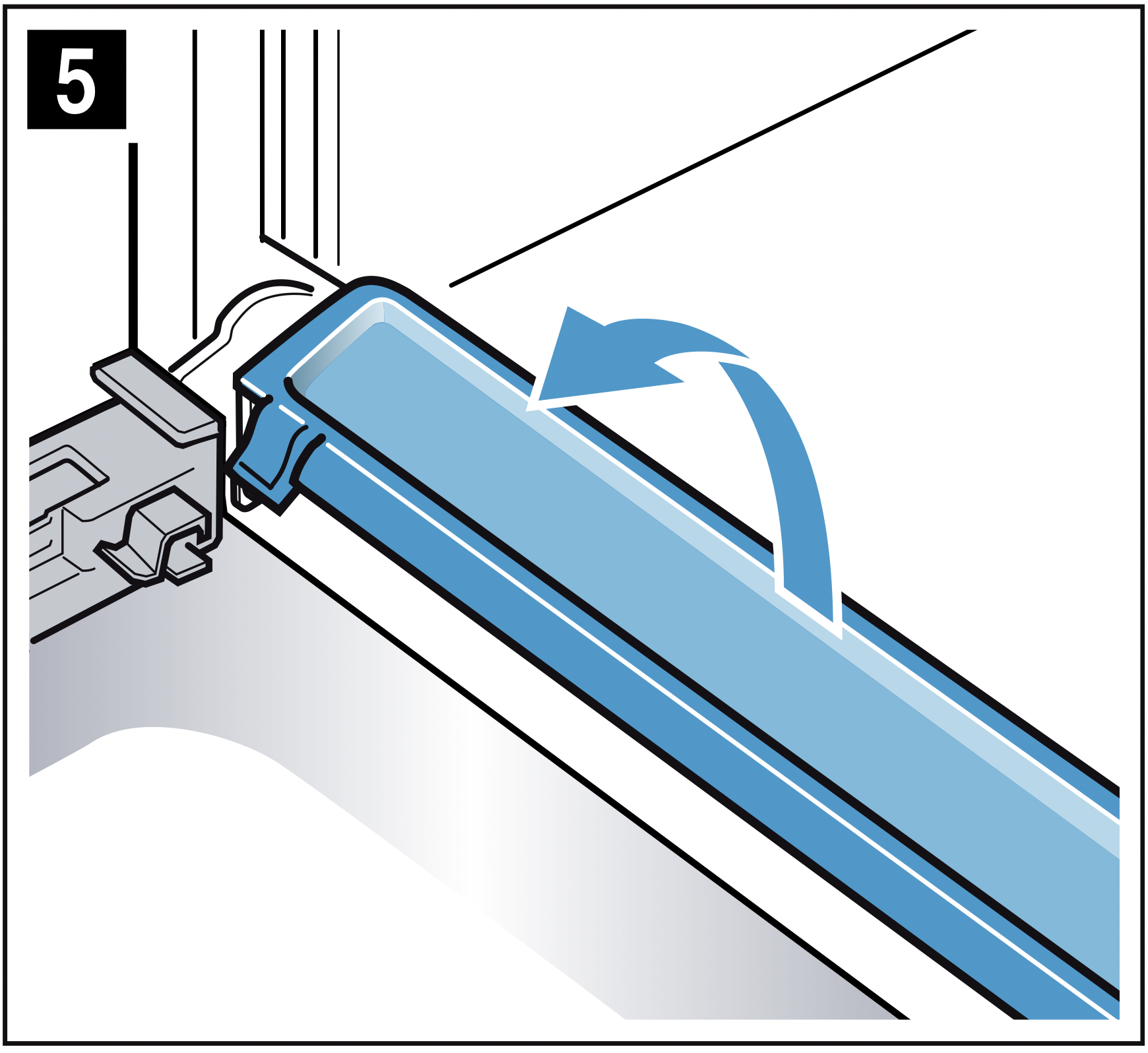
Clean the panels with glass cleaner and a soft cloth. Wipe the condensate trough with a cloth and some hot soapy water.
Warning - Risk of injury!
- Scratched glass in the appliance door may develop into a crack. Do not use a glass scraper, sharp or abrasive cleaning aids or detergents.
- The hinges on the appliance door move when opening and closing the door, and you may be trapped. Keep your hands away from the hinges.
Fitting panels
- Open the appliance door fully and refit the condensate trough. To do this, insert the trough from above and rotate it at the bottom (fig. 1).
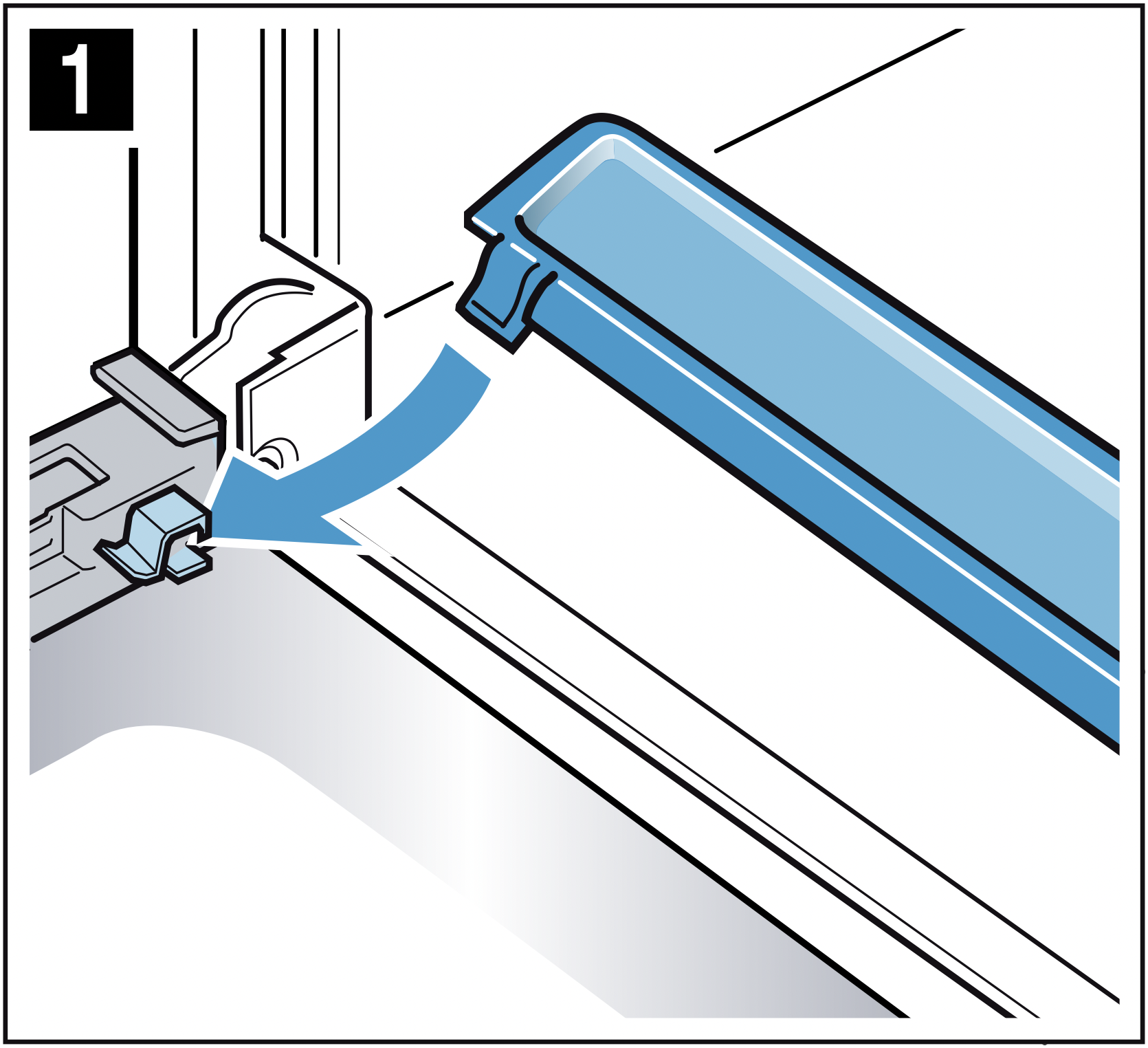
- Close the appliance door fully.
- Slide each panel back in and make sure that it is sitting correctly at the bottom in the retainer (fig. 2).
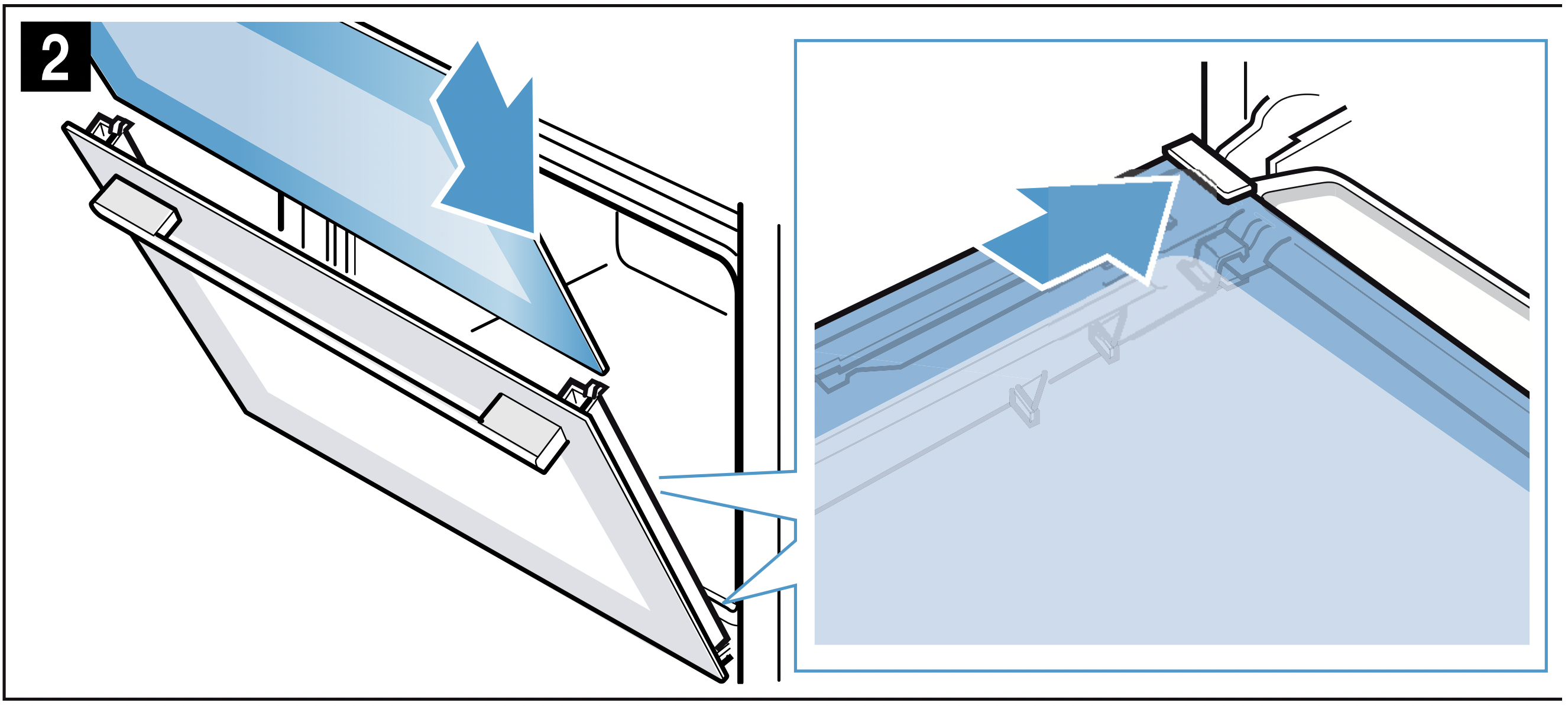
- Push each panel in at the top (fig. 3).

- Put the cover back in place and press on it until you hear it click into place (fig. 4).
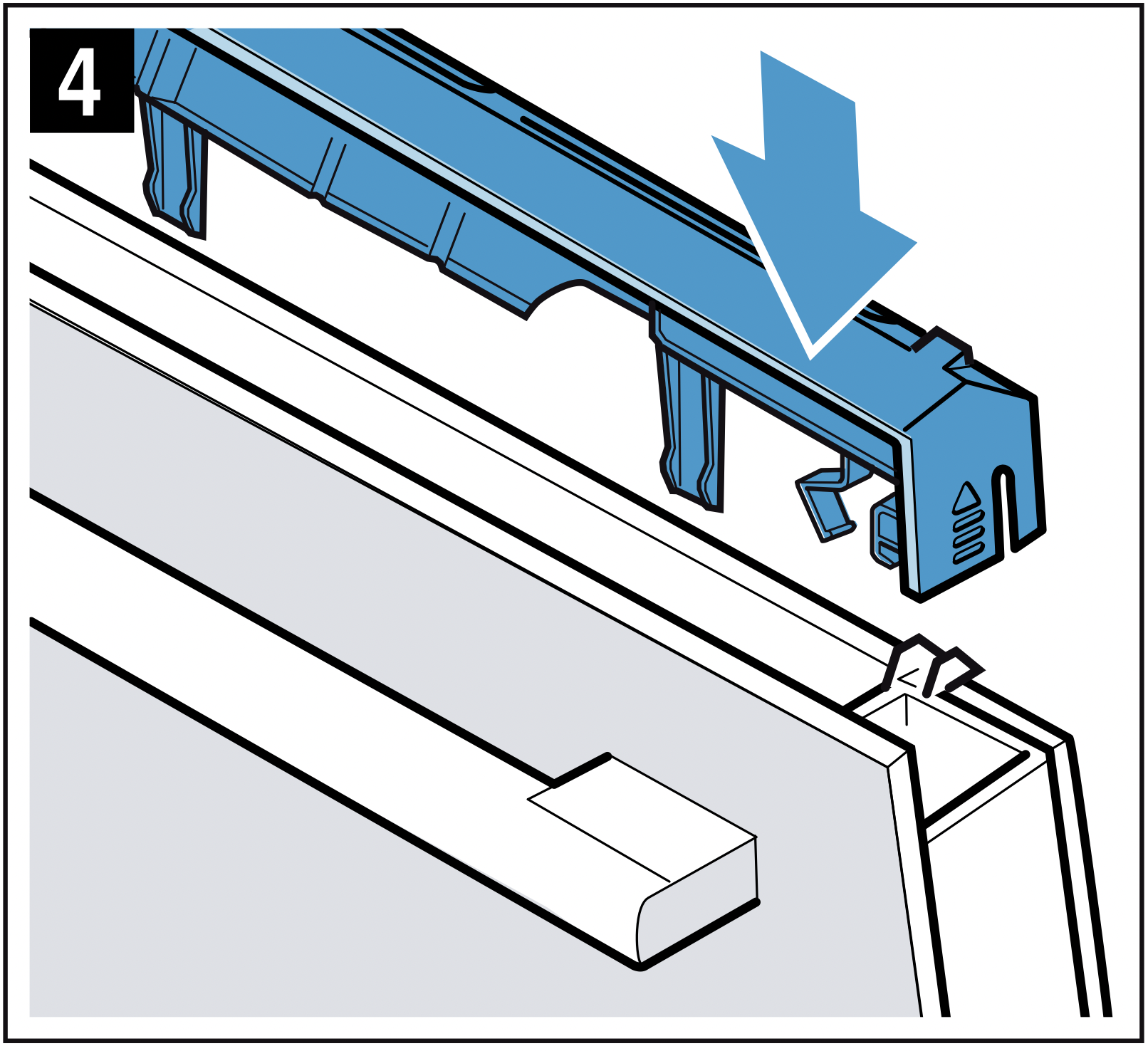
- Open the appliance door again fully.
- Close the two locking levers on the left and right (fig. 5).
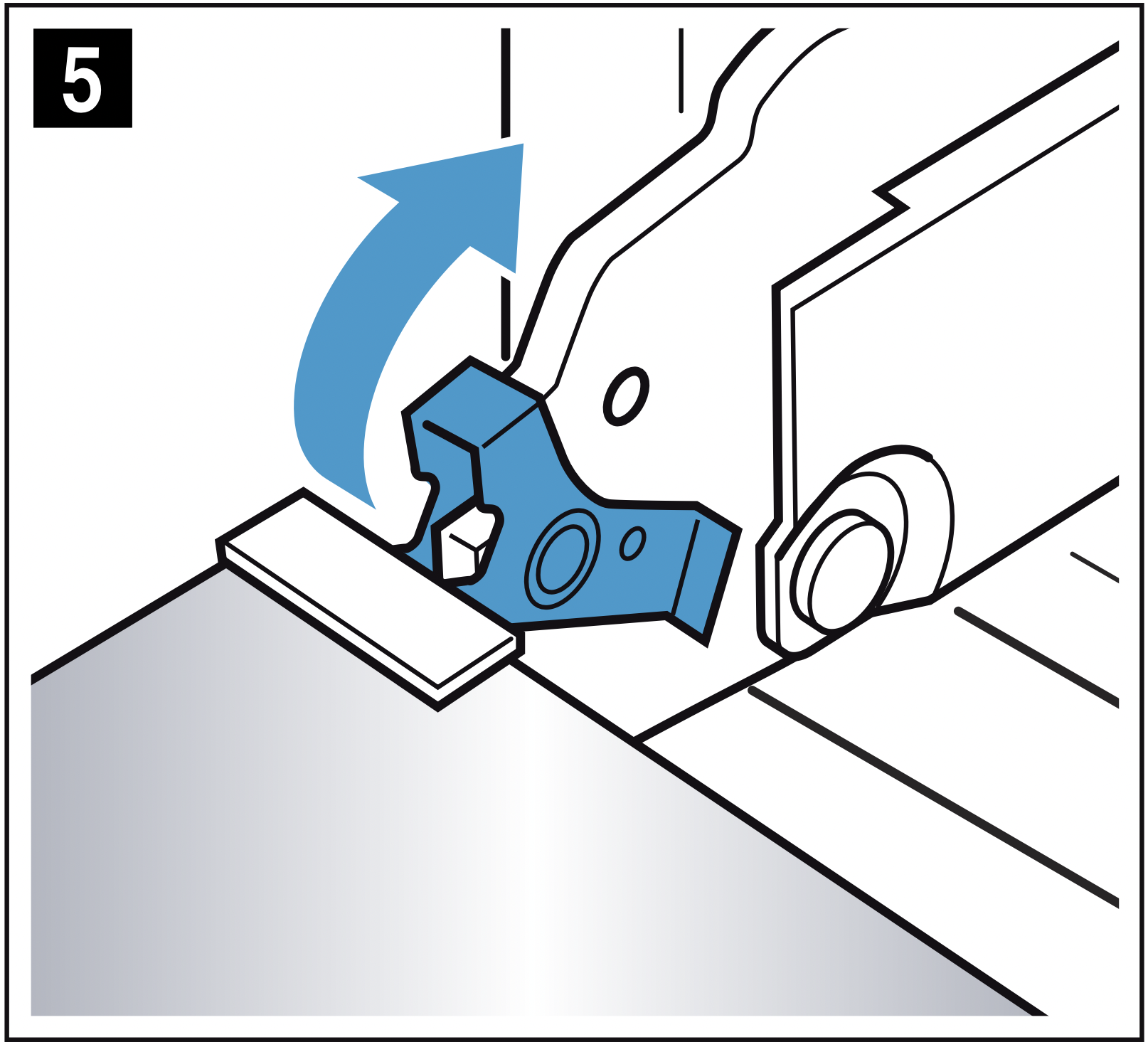
- Close the appliance door.
Caution! Do not use the cooking compartment again until the panels have been correctly fitted.
Top oven – Fitting and removing the glass panels
To facilitate cleaning, you can remove the glass panels from the appliance door.
The appliance door hinges each have a locking lever. When the locking levers are closed (fig. 1), the appliance door is secured in place. It cannot be detached.
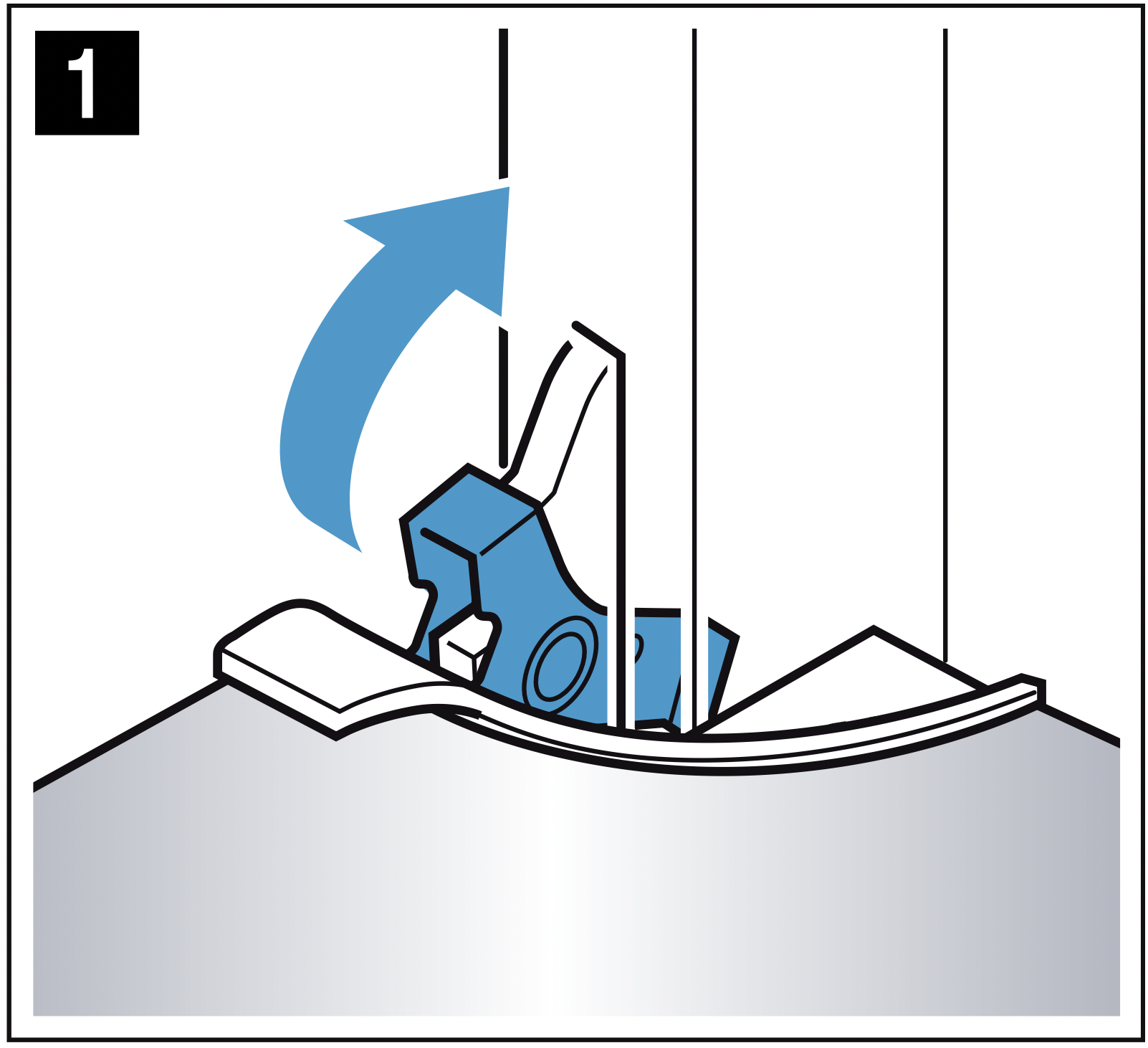
When the locking levers are open in order to detach the appliance door (fig. 2), the hinges are locked. They cannot snap shut.
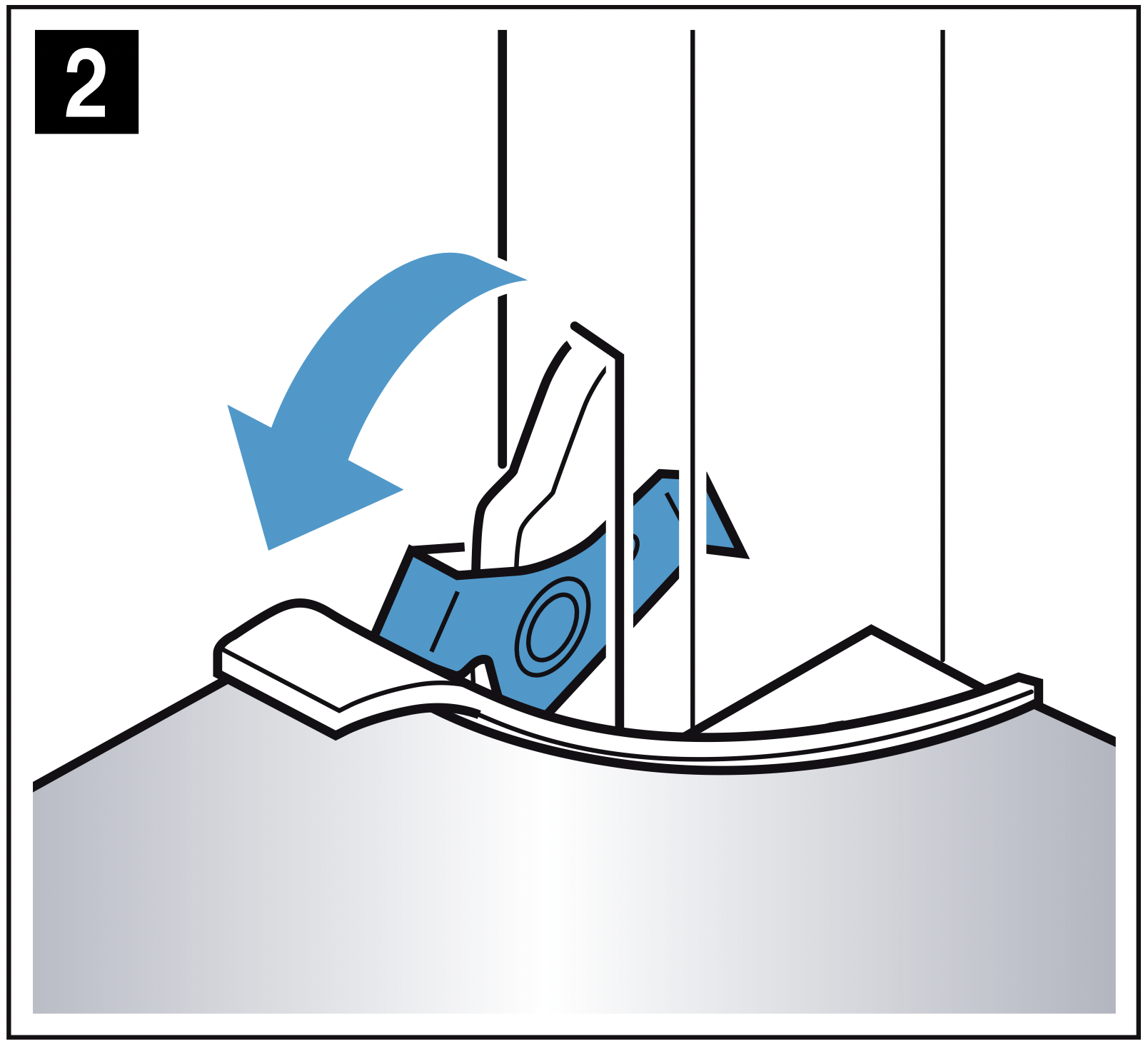
Warning - Risk of injury!
- If the hinges are not locked, they can snap shut with great force. Ensure that the locking levers are always fully closed or, when detaching the appliance door, fully open.
- The hinges on the appliance door move when opening and closing the door, and you may be trapped. Keep your hands away from the hinges.
Removing panels
- Open the appliance door fully.
- Open the two locking levers on the left and right (fig. 1).
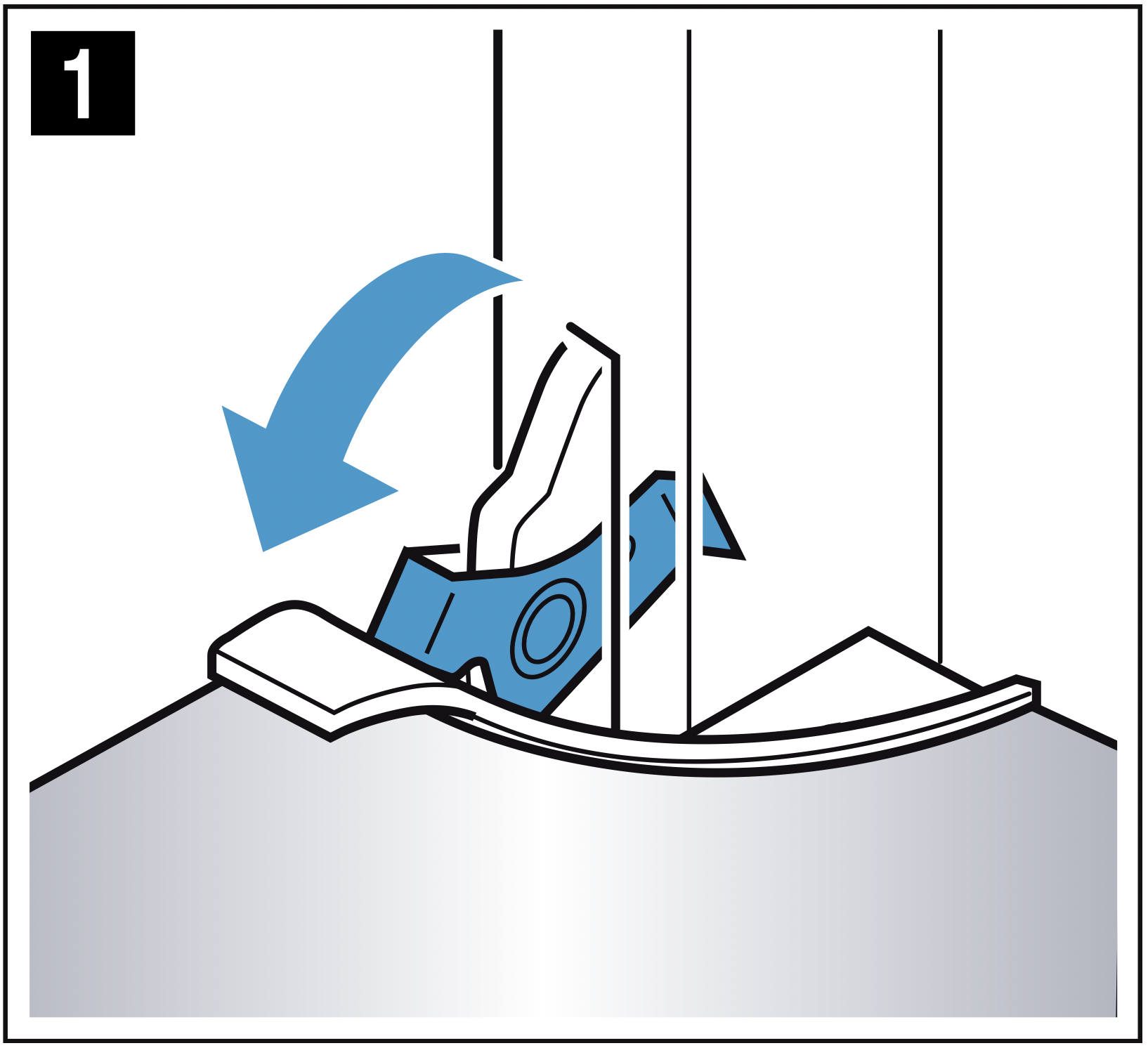
- Close the appliance door fully a. Take hold of the appliance door with both hands, one on the left and one on the right b, and pull it up and out (fig. 2).
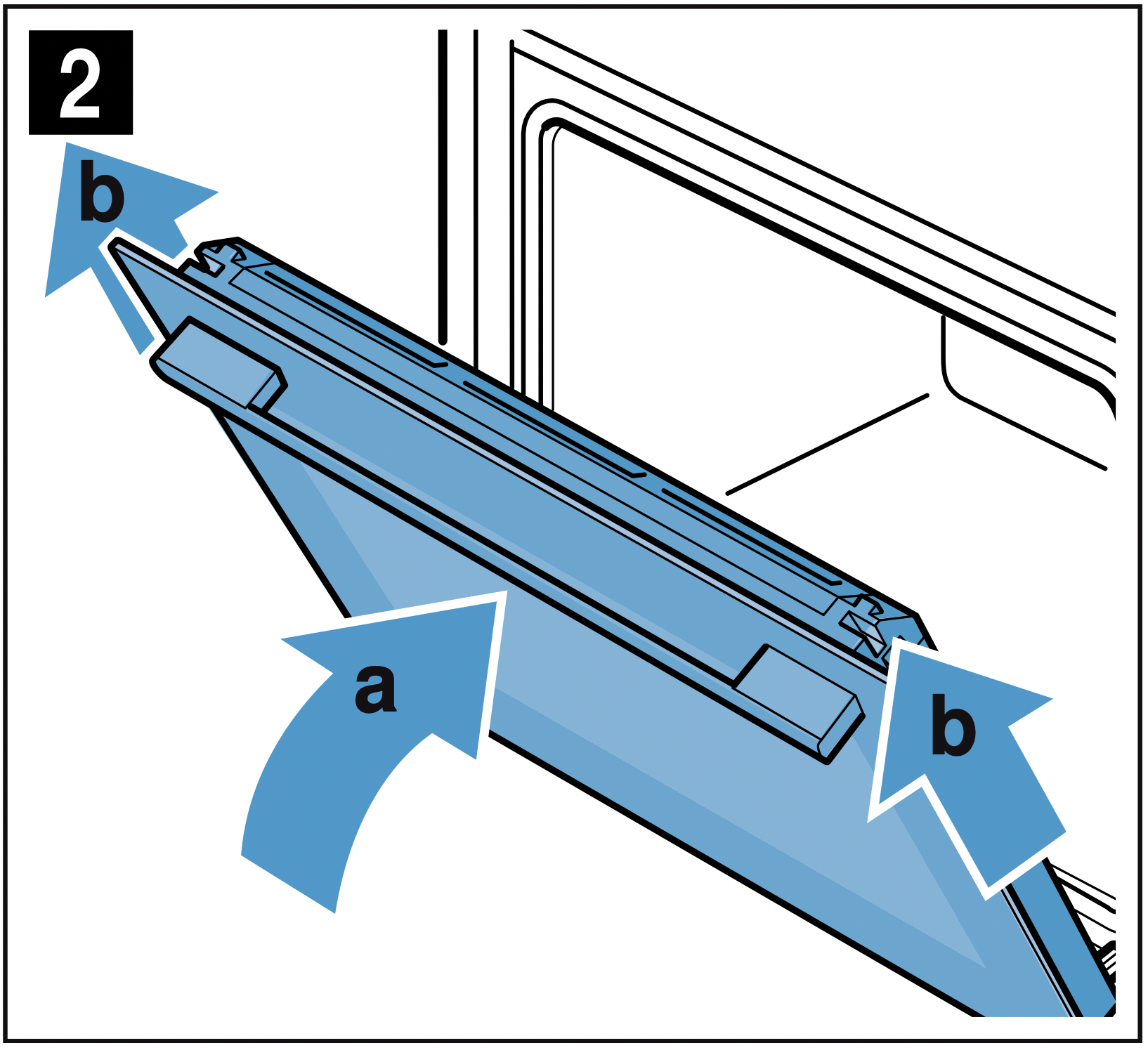
- Set the appliance door down carefully on a level surface.
- Press the left- and right-hand sides of the cover (fig. 3).

- Remove the cover (fig. 4).

- Lift out each panel (fig. 5) and set them down carefully on a flat surface.
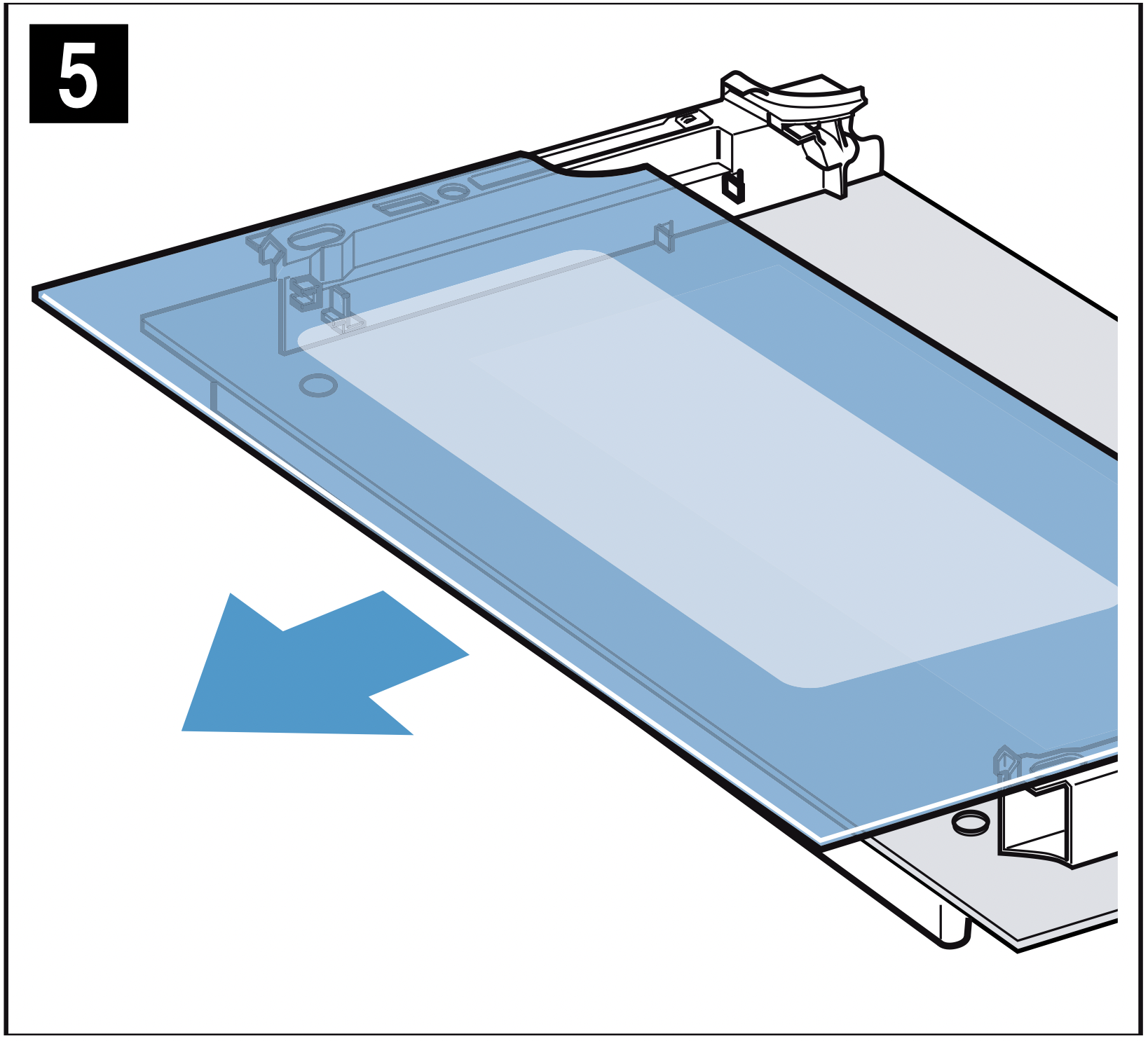
Clean the panels with glass cleaner and a soft cloth.
Warning - Risk of injury!
- Scratched glass in the appliance door may develop into a crack. Do not use a glass scraper, sharp or abrasive cleaning aids or detergents.
- The hinges on the appliance door move when opening and closing the door, and you may be trapped. Keep your hands away from the hinges.
Fitting panels
- Slide each panel back in and make sure that it is sitting correctly at the bottom in the retainer (fig. 1).
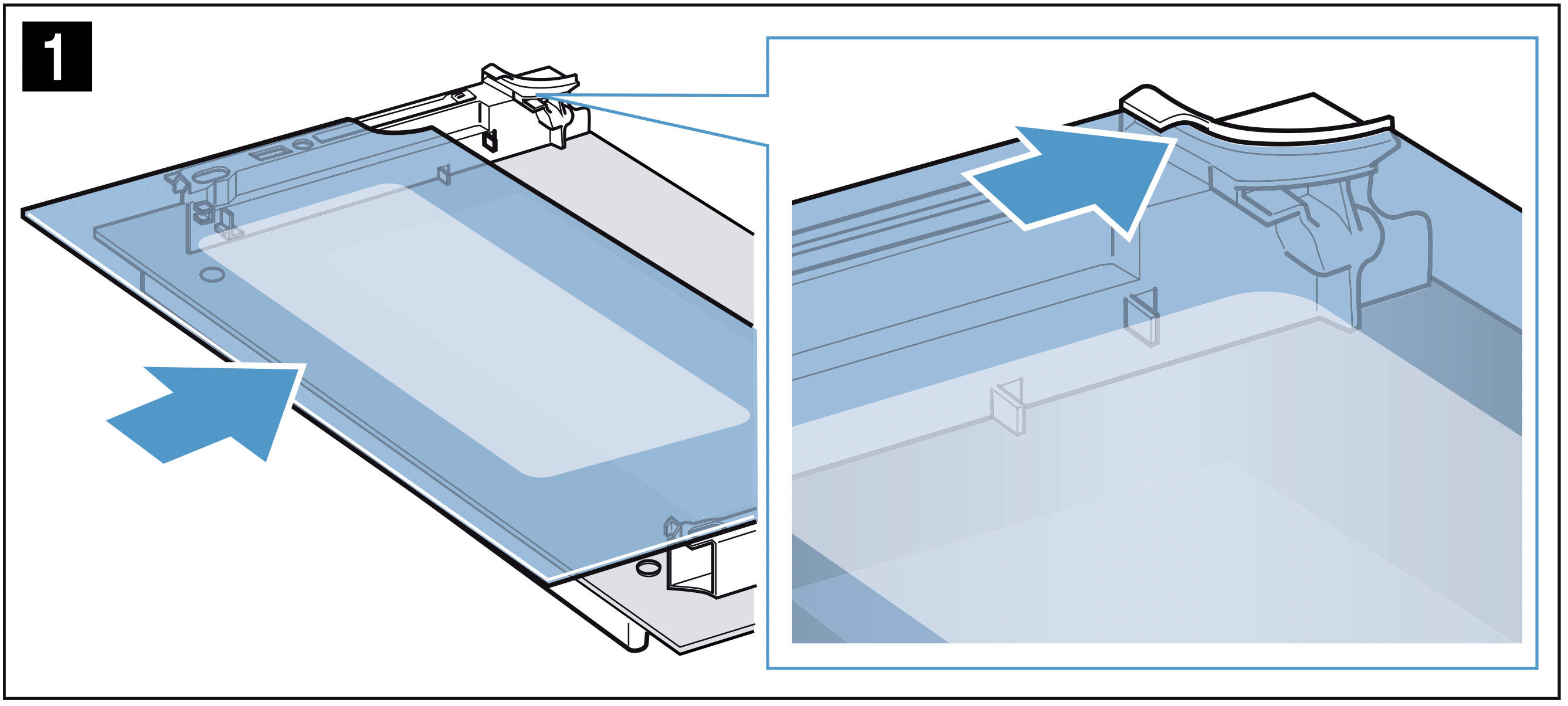
- Push each panel in at the top (fig. 2).
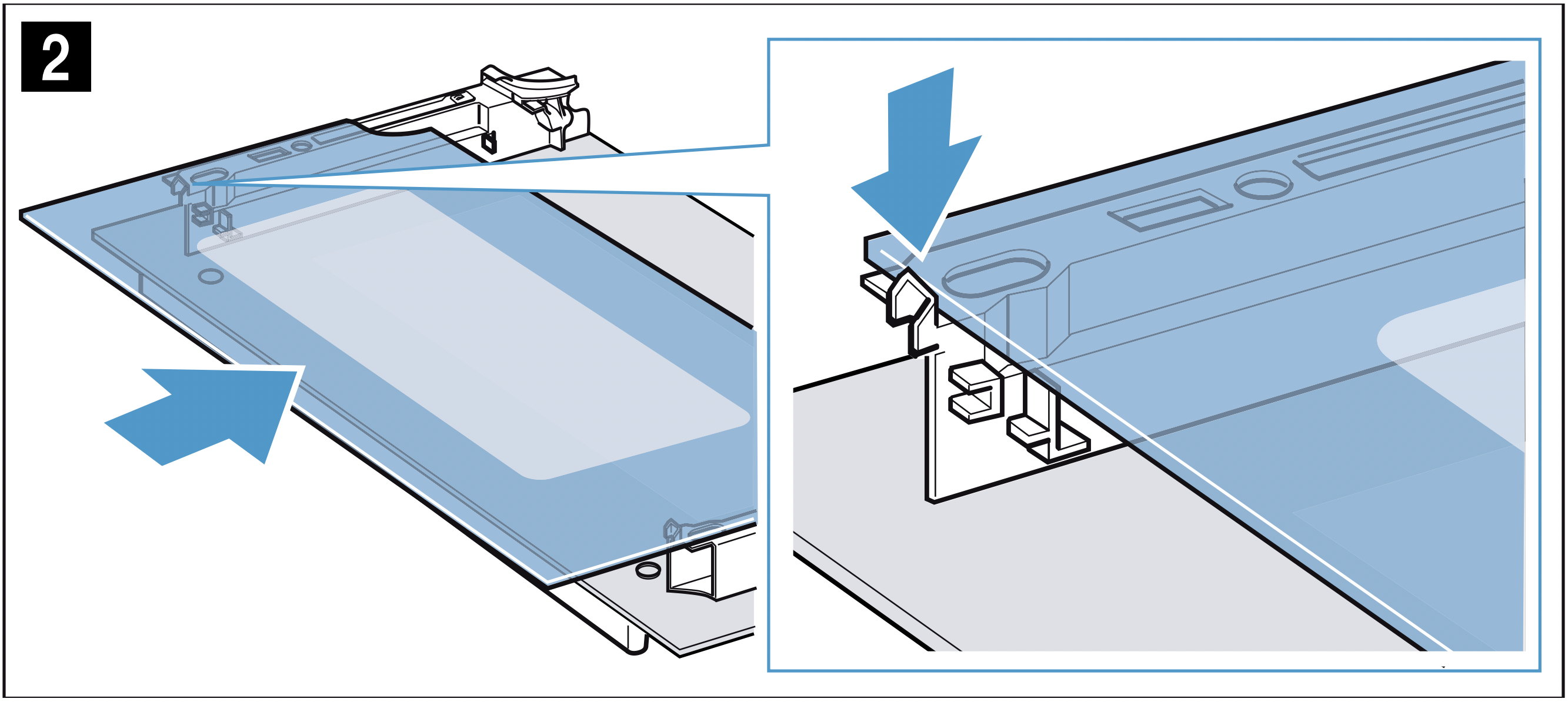
- Put the cover back in place and press on it until you hear it click into place (fig. 3).
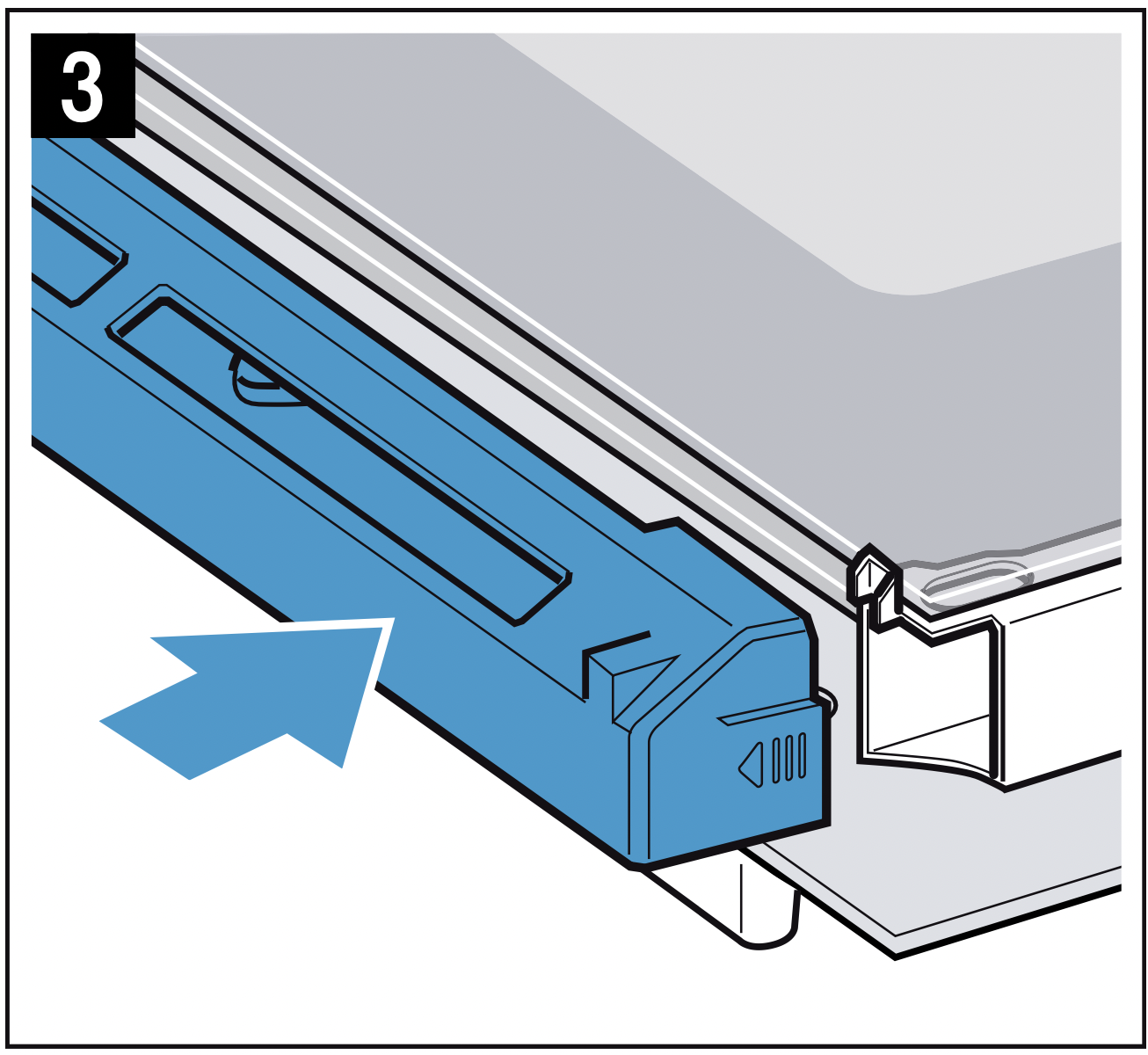
- When fitting the appliance door, ensure that both hinges are inserted straight into the opening (fig. 4). Place both hinges at the bottom on the panel and use this as a guide.
Ensure that the hinges are inserted into the correct opening. You must be able to insert them easily and without resistance. If you can feel any resistance, check that the hinges are inserted into the correct opening.

- Open the appliance door fully.
- Close the two locking levers on the left and right (fig. 5).

- Close the appliance door
Caution! Do not use the cooking compartment again until the panels have been correctly fitted.
Trouble shooting
If a fault occurs, there is often a simple explanation. Before calling the after-sales service, please refer to the fault table and attempt to correct the fault yourself.
Rectifying faults yourself
You can often easily rectify technical faults with the appliance yourself.
If a dish does not turn out exactly as you wanted, you can find useful cooking tips and instructions at the end of this instruction manual. "Tested for you in our cooking studio" on page 27
|
Fault |
Possible cause |
Notes/remedy |
|
The appliance is not working. |
Defective circuit breaker. |
Check the circuit breaker in the fuse box. |
|
Power failure |
Check whether the kitchen light or other kitchen appliances are working. |
|
|
The time is flashing on the display. |
Power failure. |
Reset the time. |
|
No settings can be made on the appliance. The symbol |
The child-proof lock is activated. |
Press and hold the The childproof lock can be deactivated in the basic settings. "Basic settings" on page 16 |
Warning – Risk of injury! Incorrect repairs are dangerous. Do not attempt to repair the appliance yourself. Repairs must only be carried out by one of our trained after-sales engineers. If the appliance is defective, call the after-sales service.
Warning – Risk of electric shock! Incorrect repairs are dangerous. Repairs may only be carried out and damaged power cables replaced by one of our trained after-sales technicians. If the appliance is defective, unplug the appliance from the mains or switch off the circuit breaker in the fuse box. Contact the after-sales service.
Error messages on the display If an error message with "  " appears on the display, e.g.
" appears on the display, e.g.  touch the
touch the  button. This will reset the error message. Reset the time, if necessary.
button. This will reset the error message. Reset the time, if necessary.
If the fault was a one-off, you can continue to use your appliance as normal. If the error message appears again, call our after-sales service and quote the exact error message and the E no. of your appliance. "Customer service" on page 26
Replacing the bulb in the top of the cooking compartment
If the cooking compartment light bulb fails, it must be replaced. Heat-resistant, 25 watt, 230 V halogen bulbs are available from the after-sales service or specialist retailers.
When handling the halogen bulb, use a dry cloth. This will increase the service life of the bulb. Only use these bulbs.
Warning – Risk of electric shock! When replacing the cooking compartment bulb, the bulb socket contacts are live. Before replacing the bulb, unplug the appliance from the mains or switch off the circuit breaker in the fuse box.
Warning – Risk of burns! The appliance becomes very hot. Never touch the interior surfaces of the cooking compartment or the heating elements. Always allow the appliance to cool down. Keep children at a safe distance.
- Place a tea towel in the cold cooking compartment to prevent damage.
- Turn the glass cover anti-clockwise to remove it (figure 1).
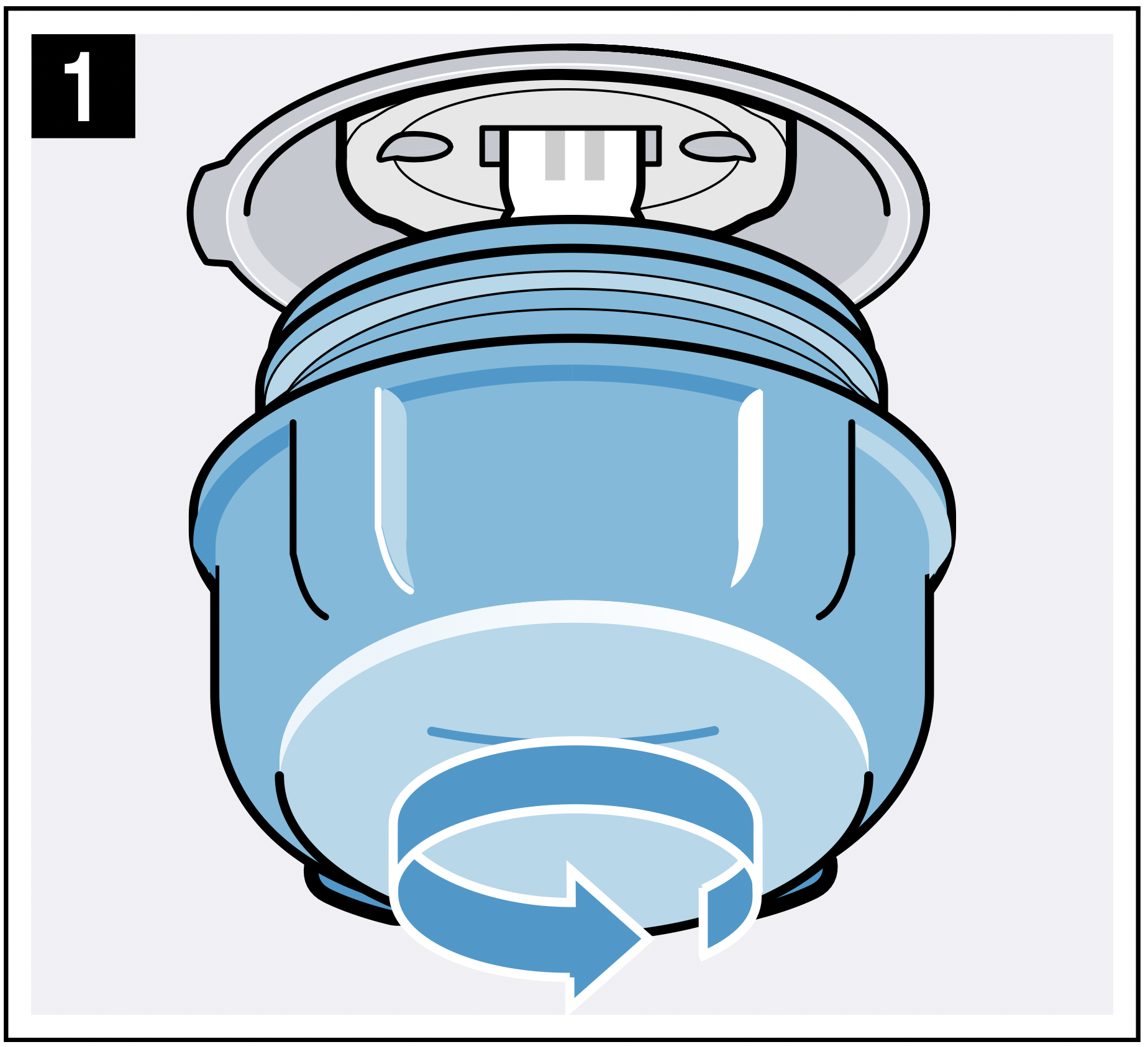
- Pull out the bulb – do not turn it (figure 2).
Insert the new bulb, making sure that the pins are in the correct position. Push the bulb in firmly.
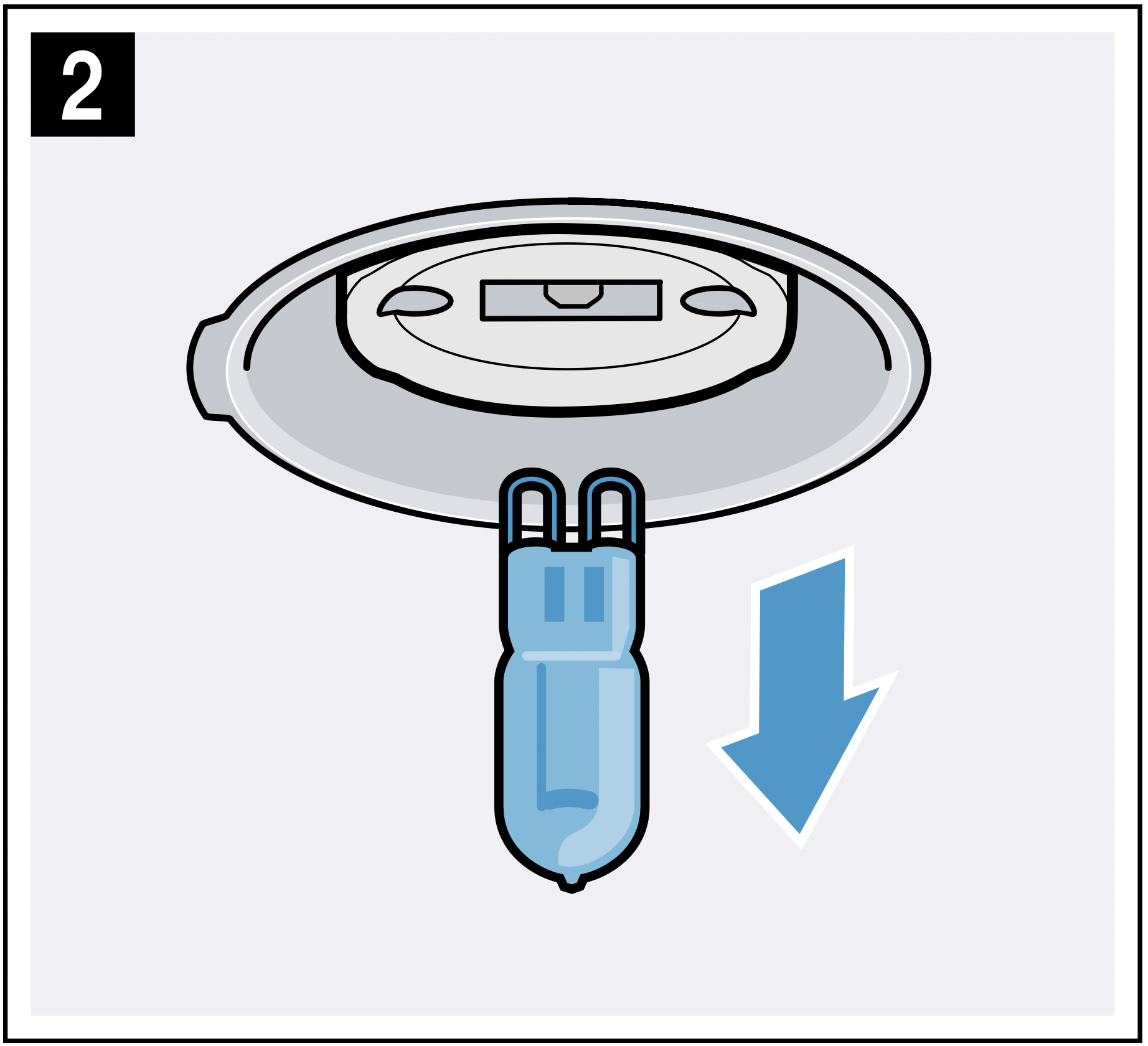
- Screw the glass cover back on.
Depending on the appliance model, the glass cover may have a sealing ring. If the glass cover has a sealing ring, put it back in place before screwing the cover back on. - Remove the tea towel and switch on the circuit breaker.
